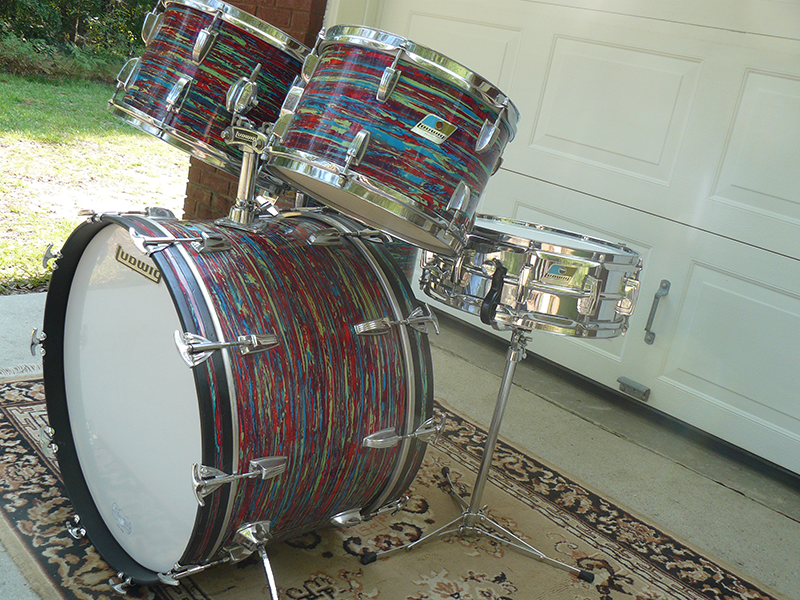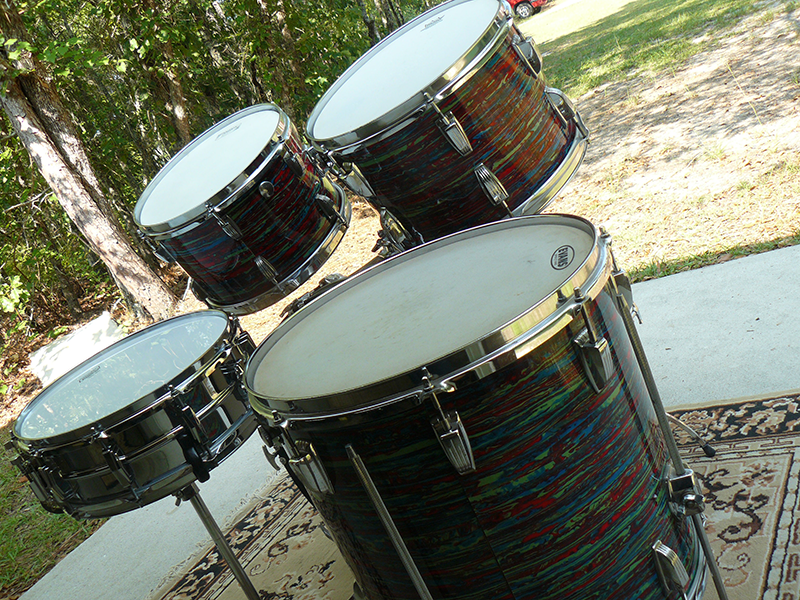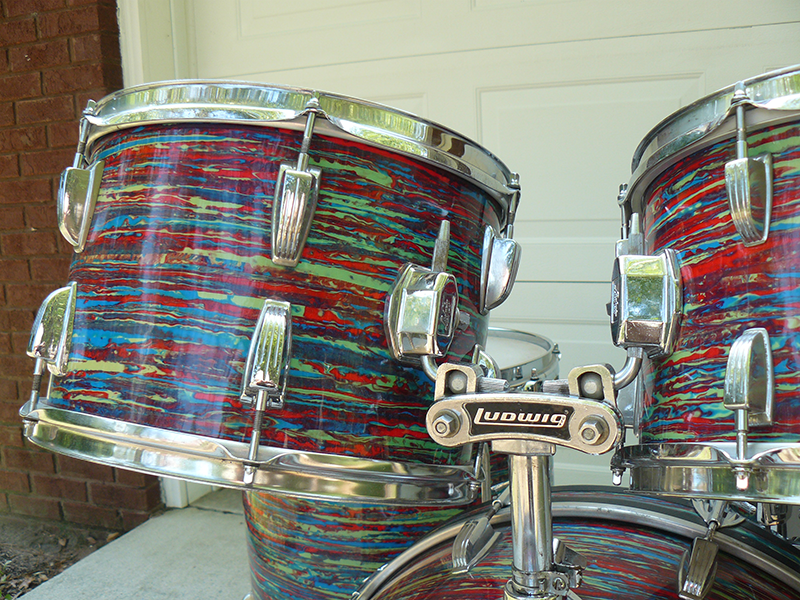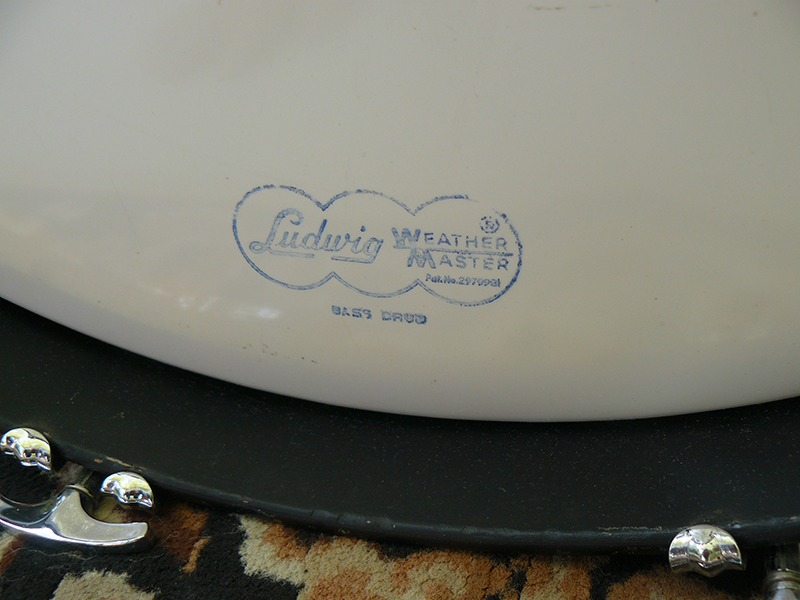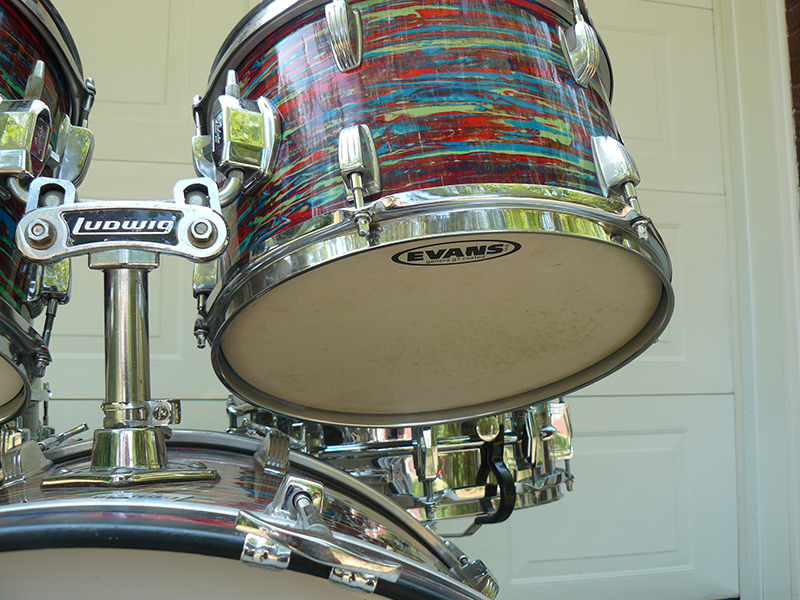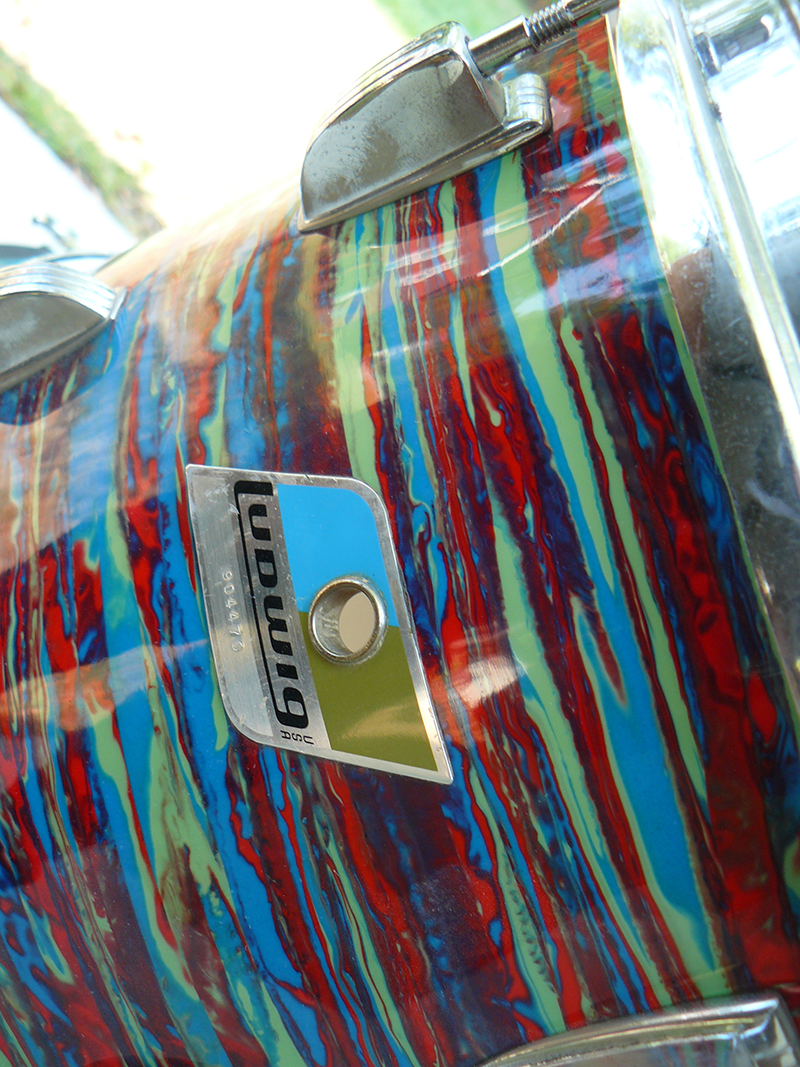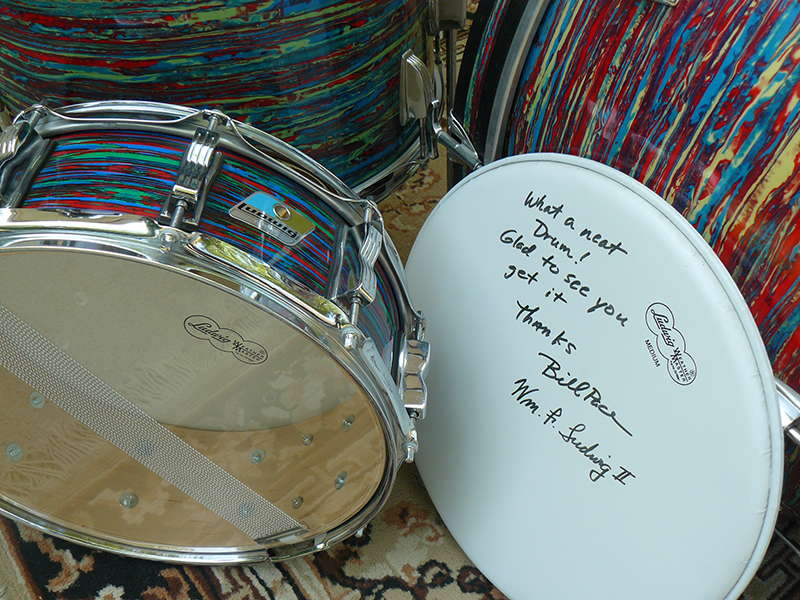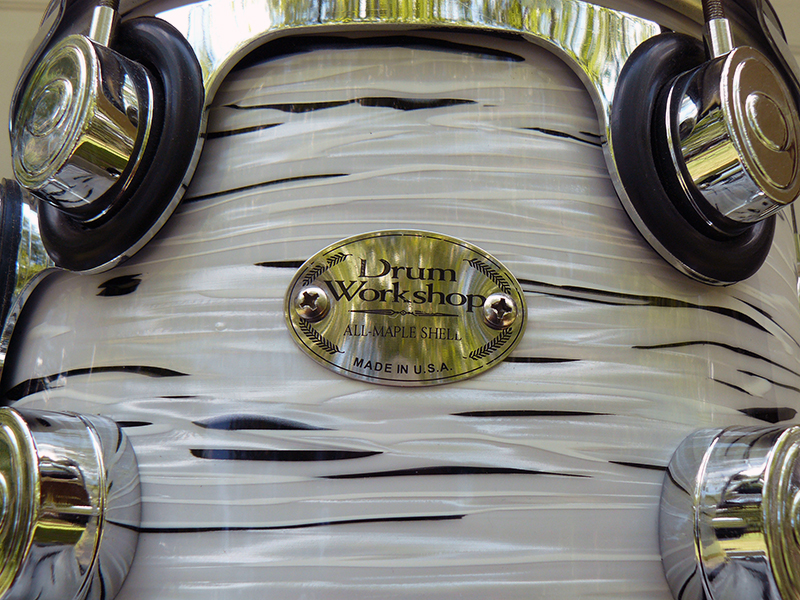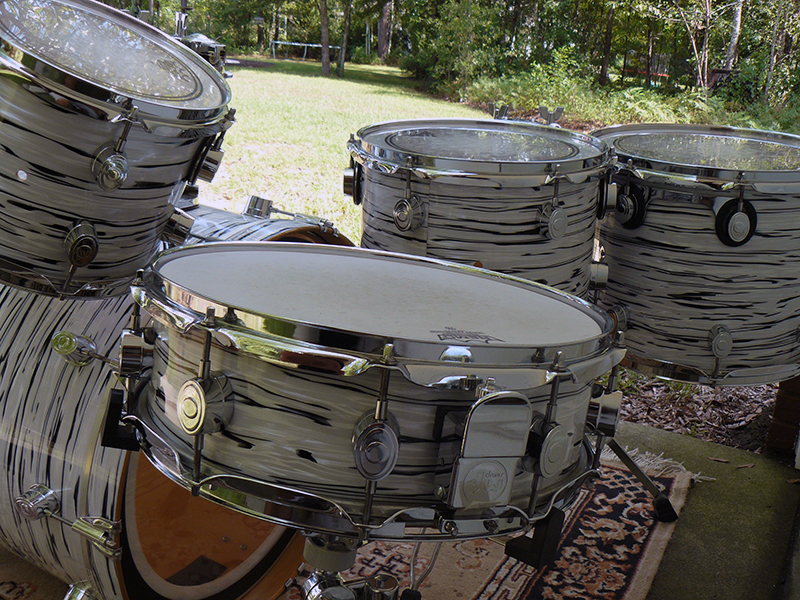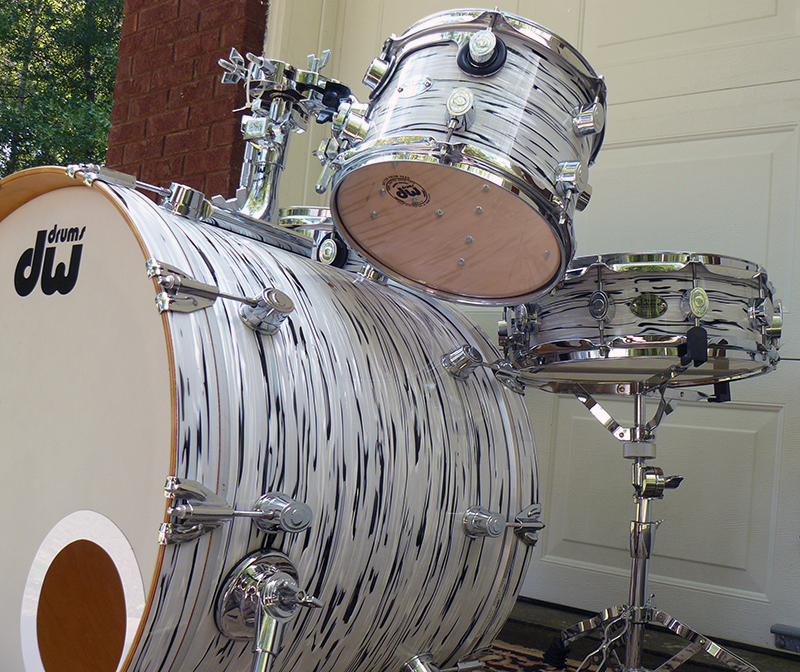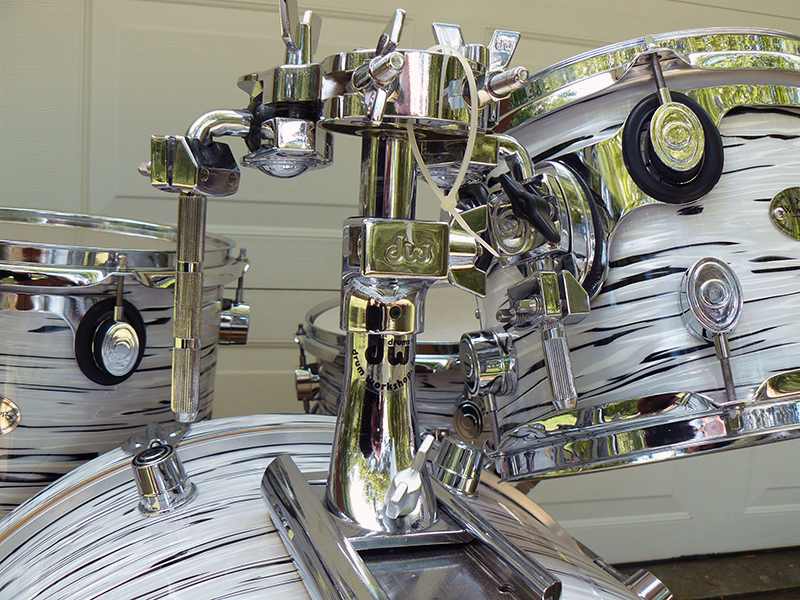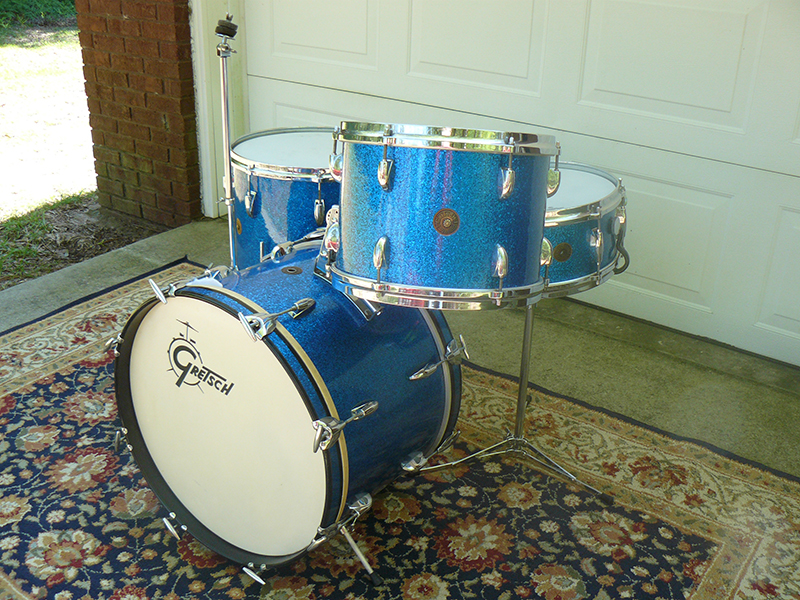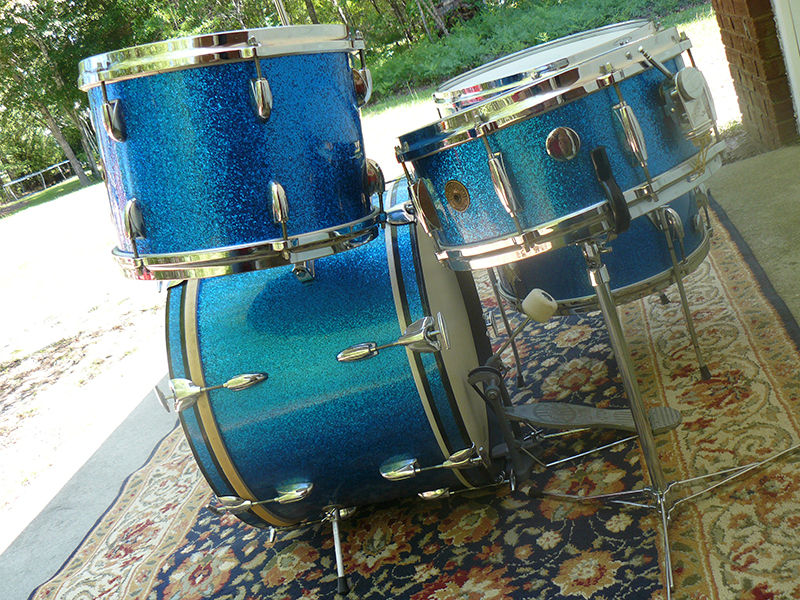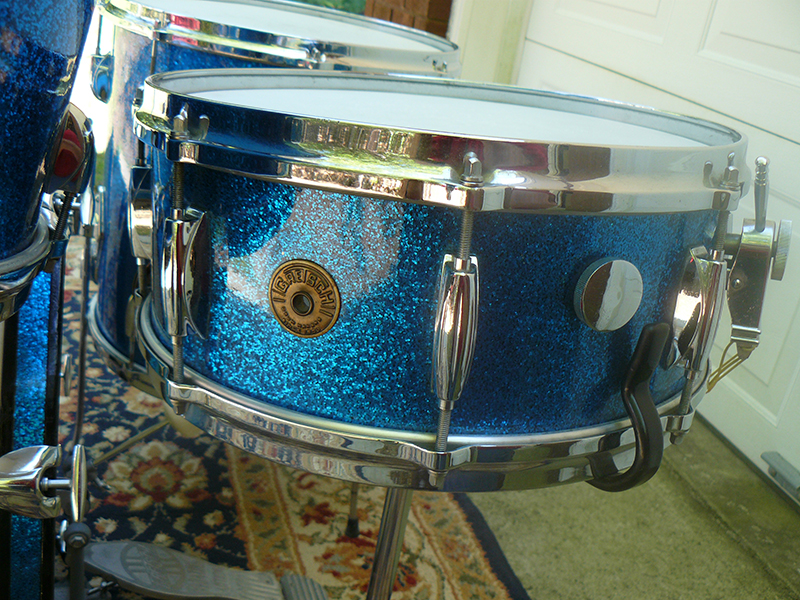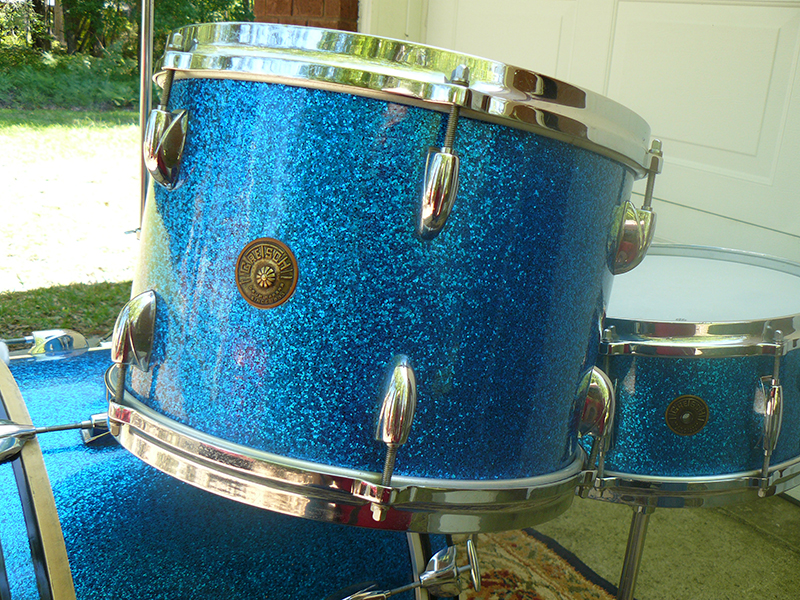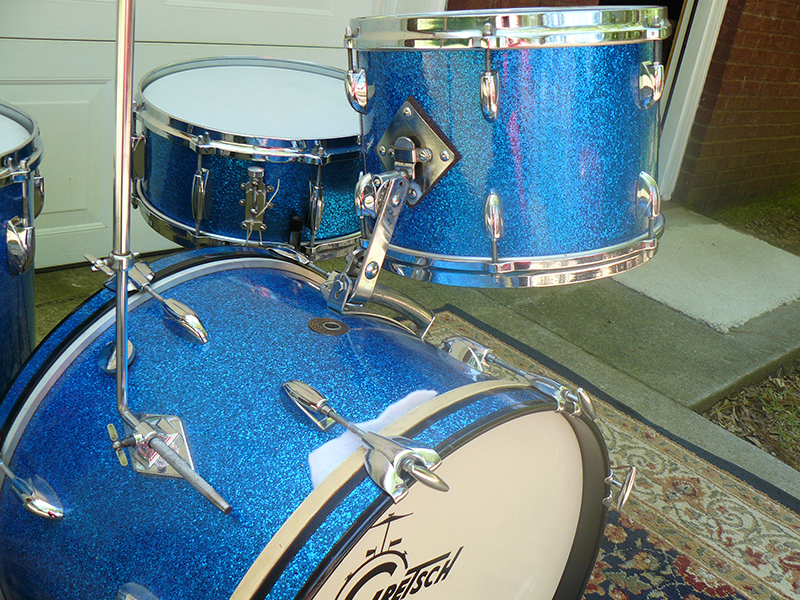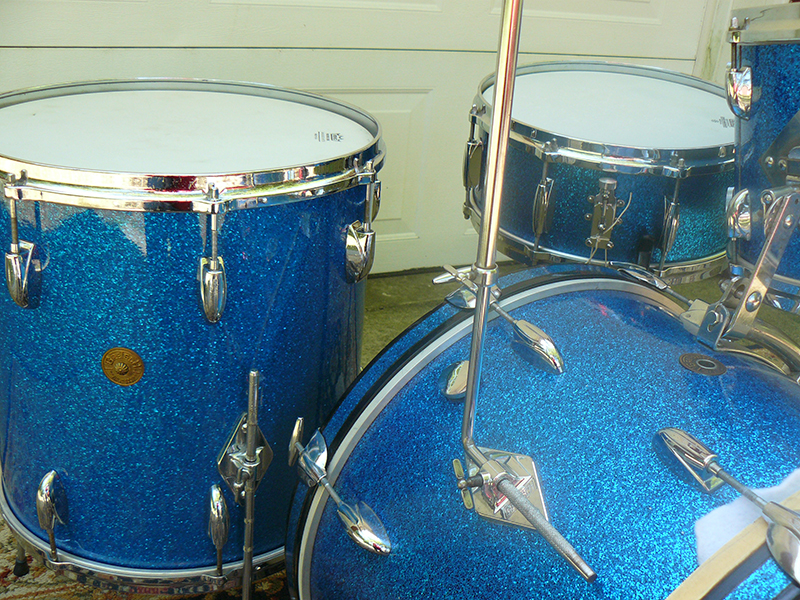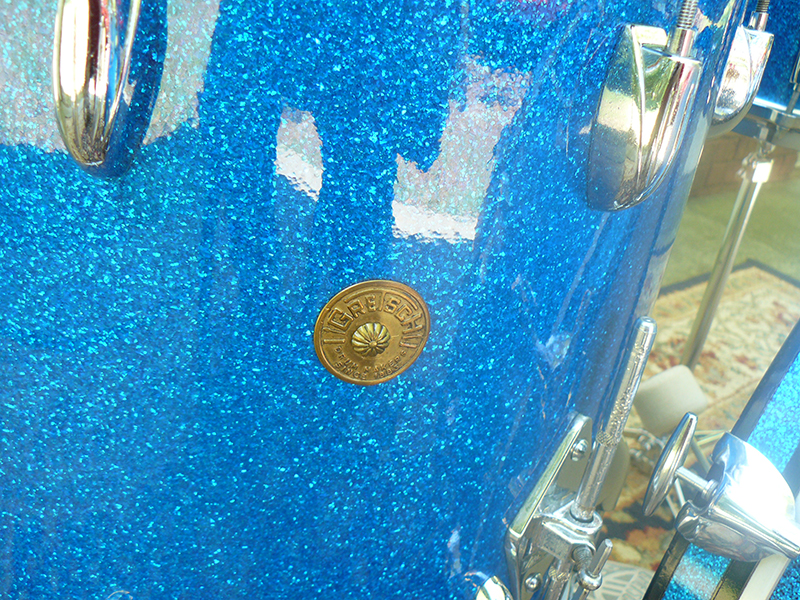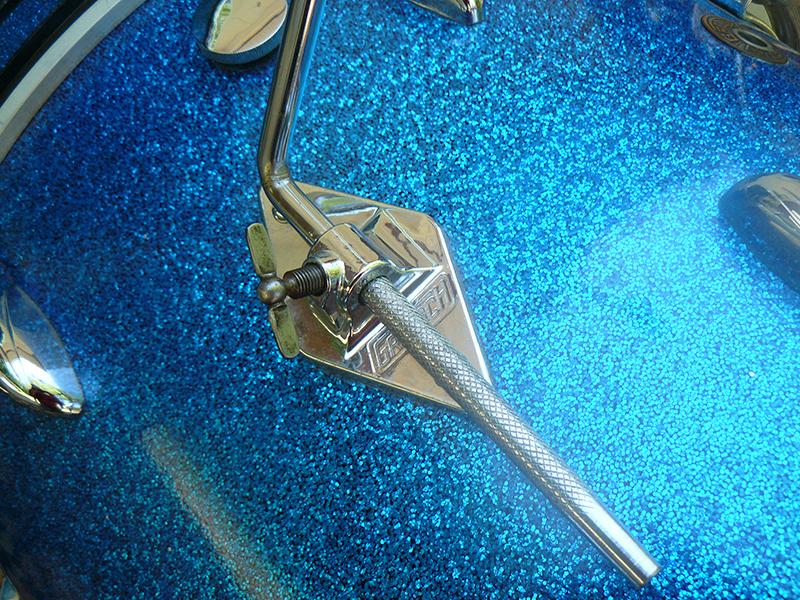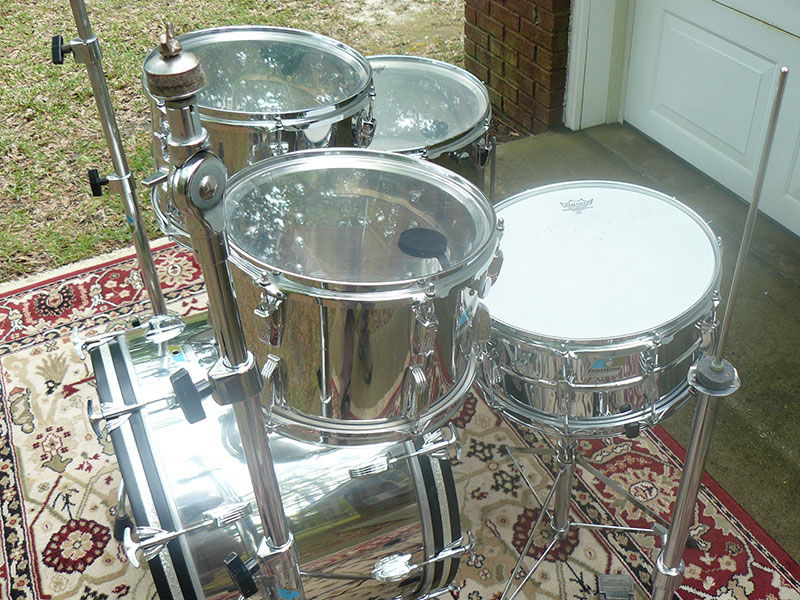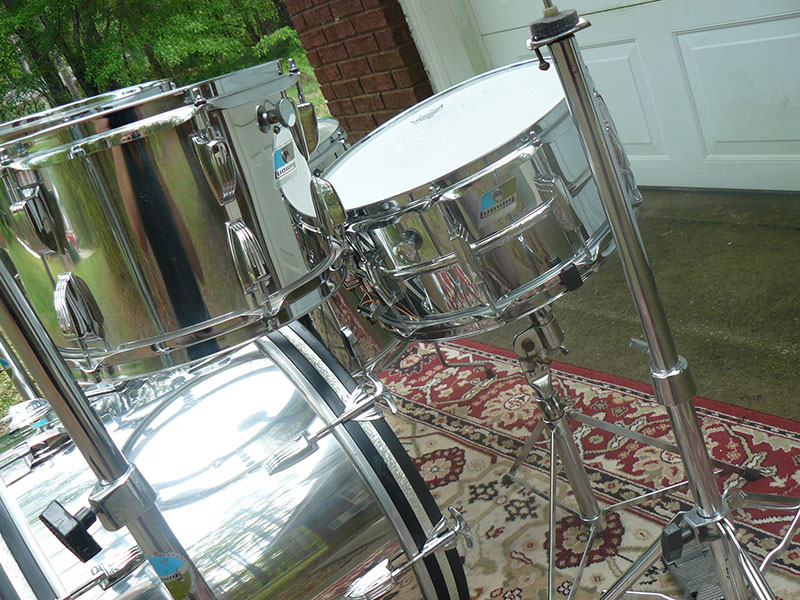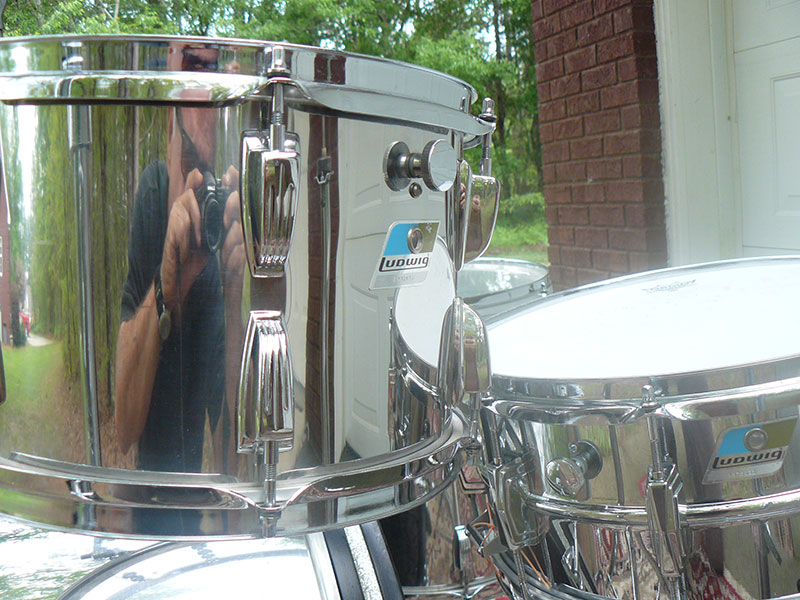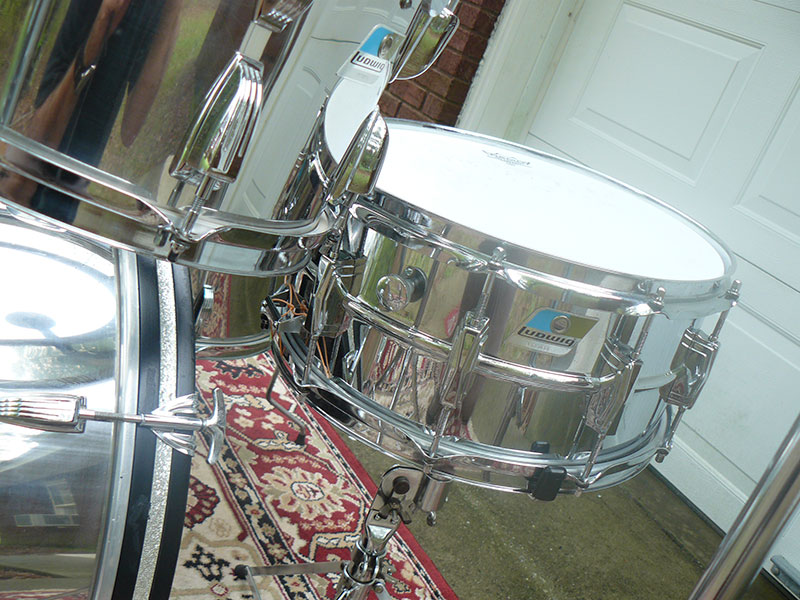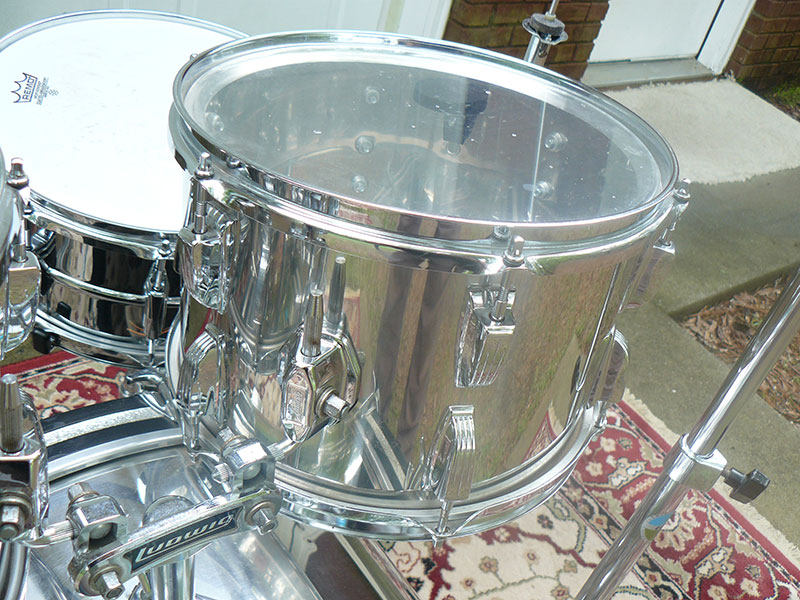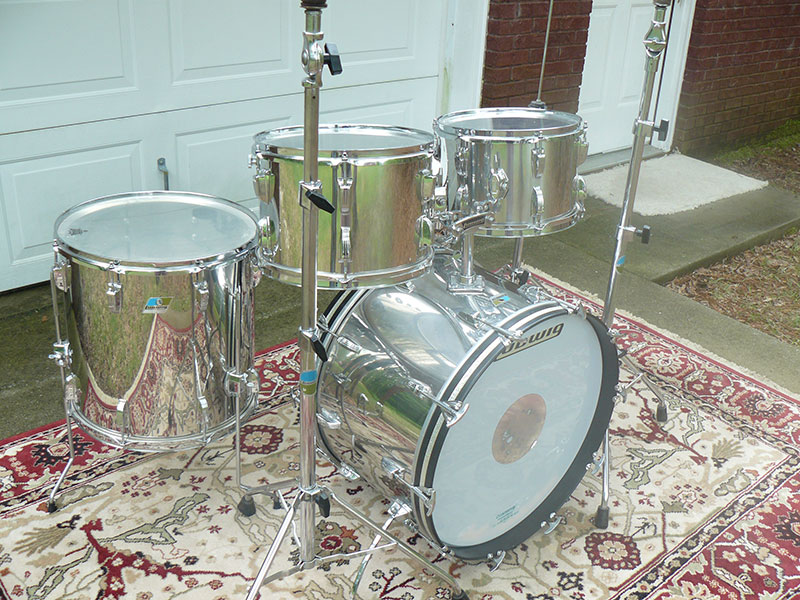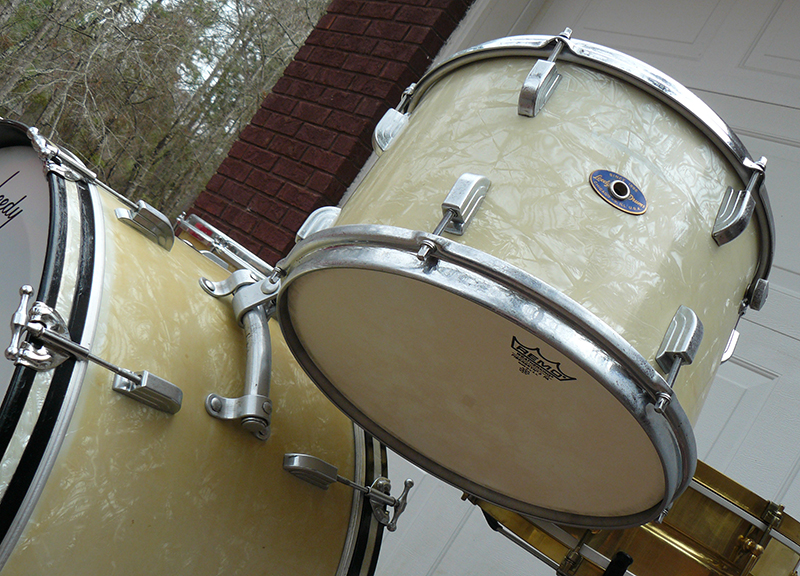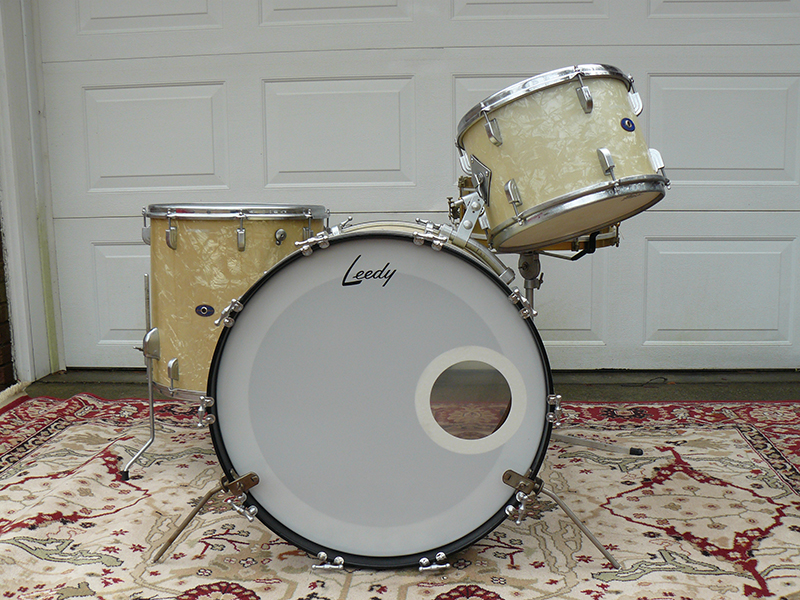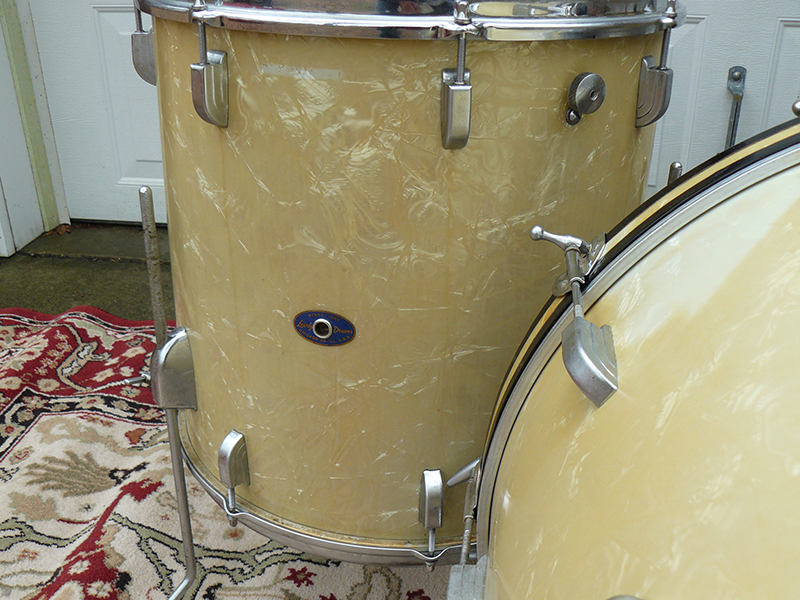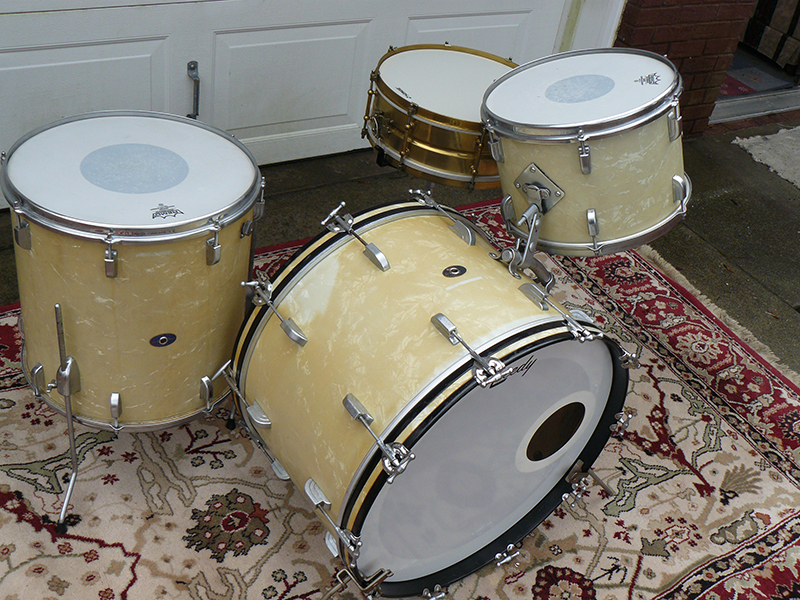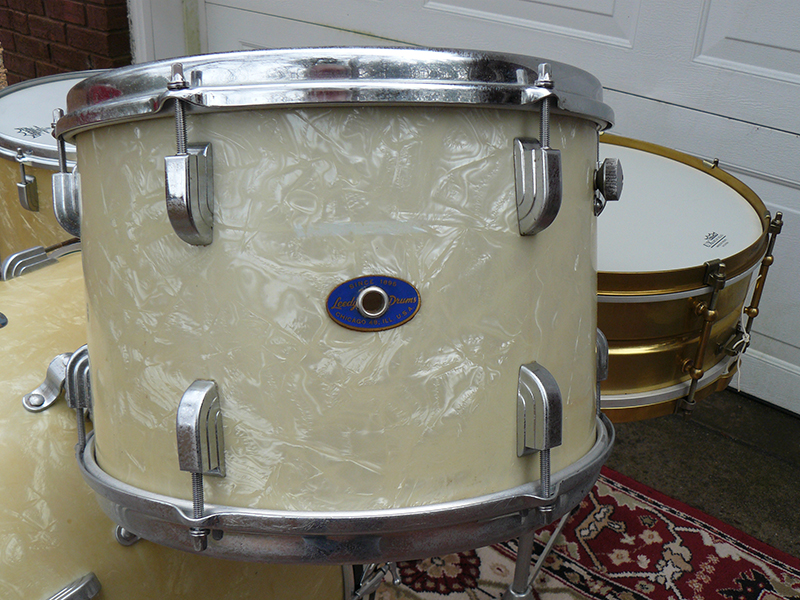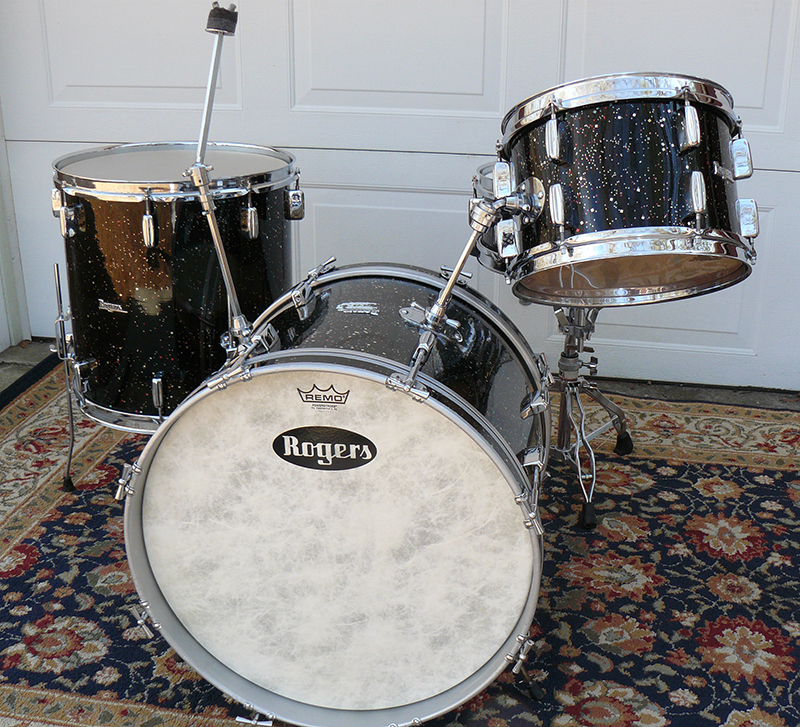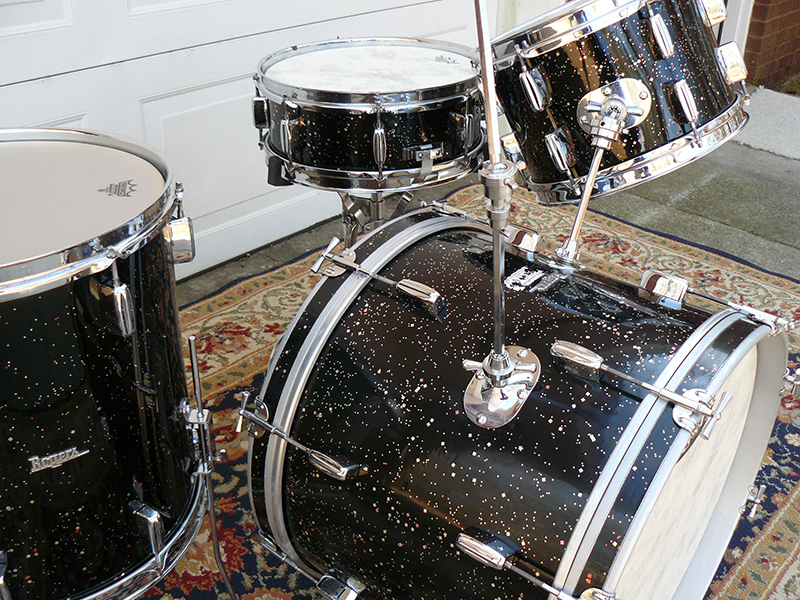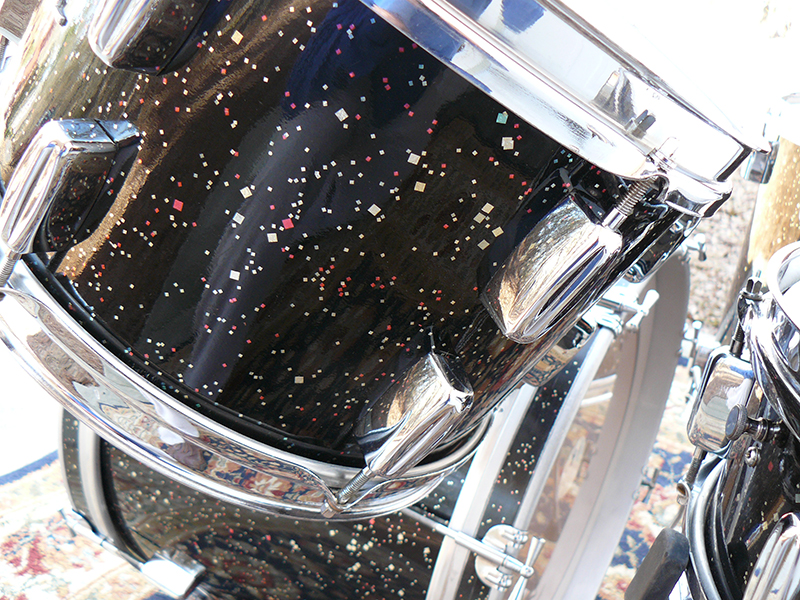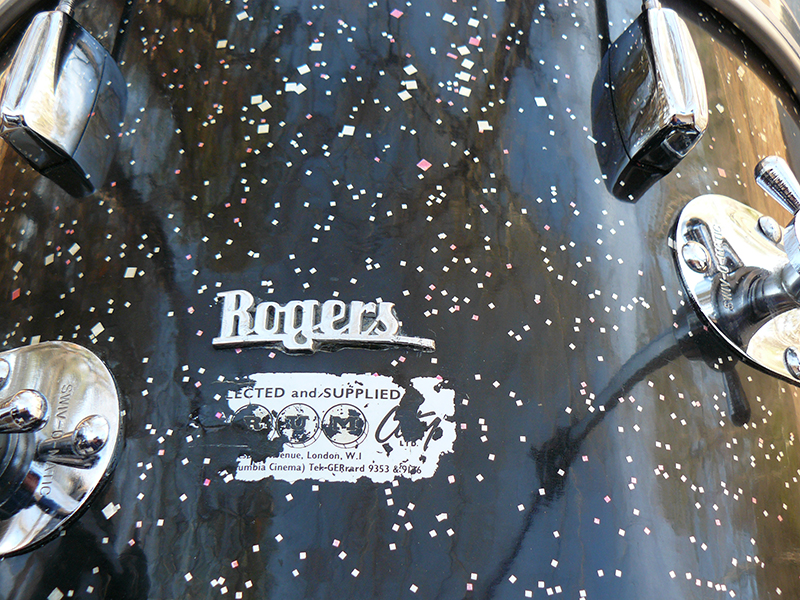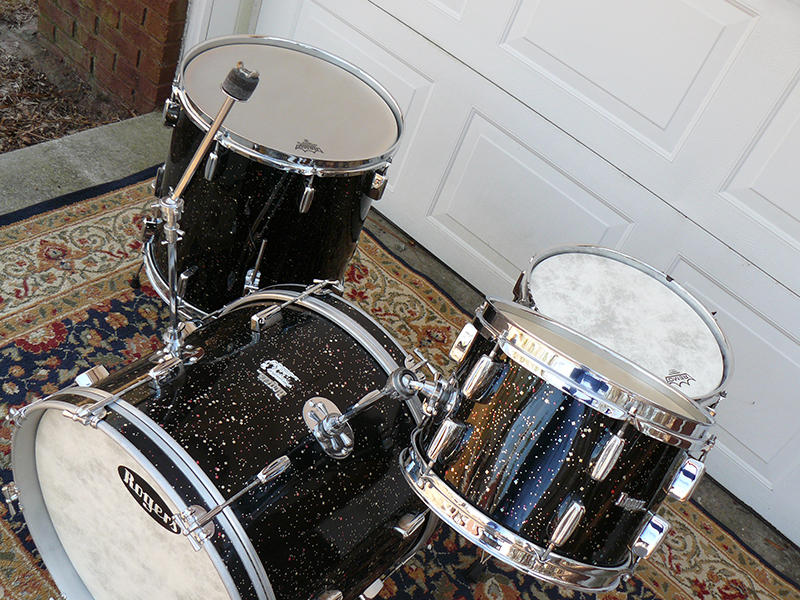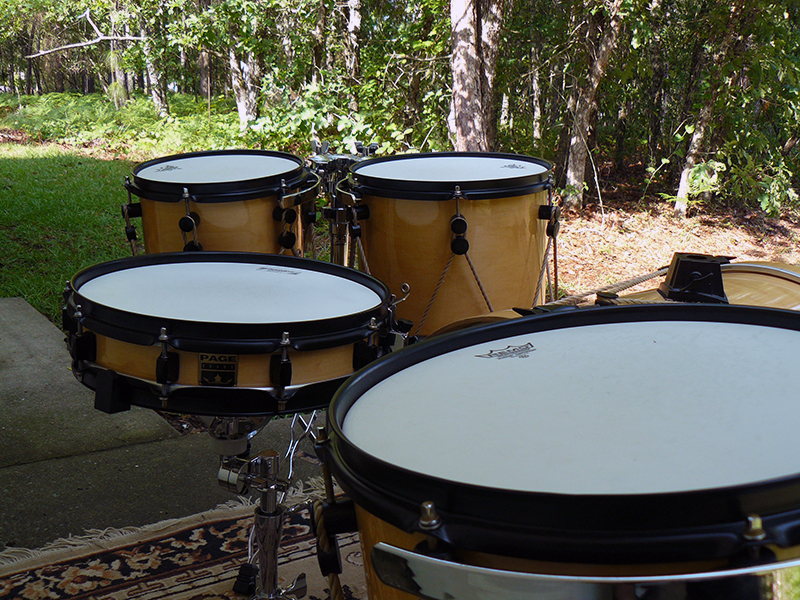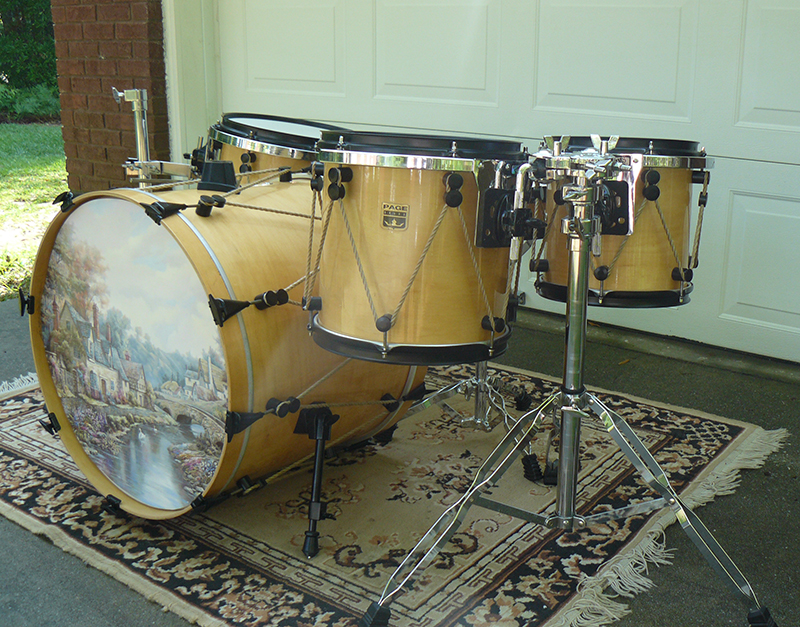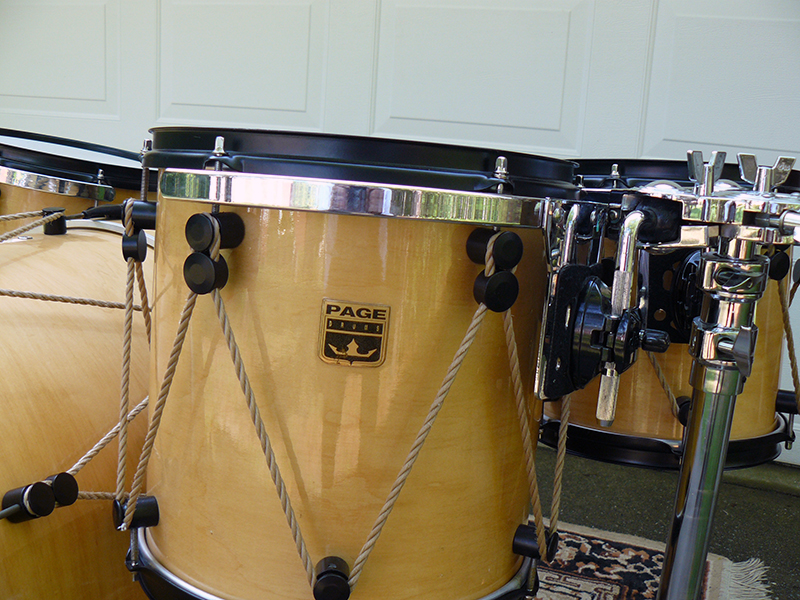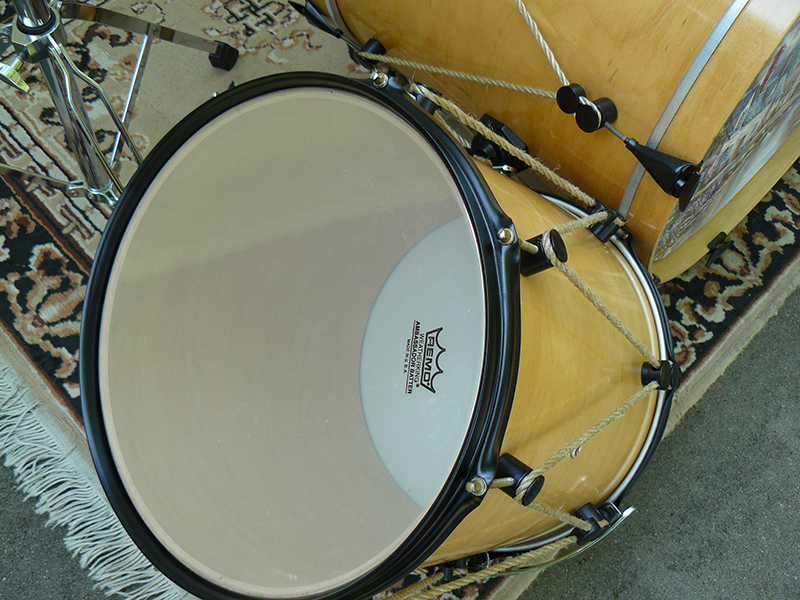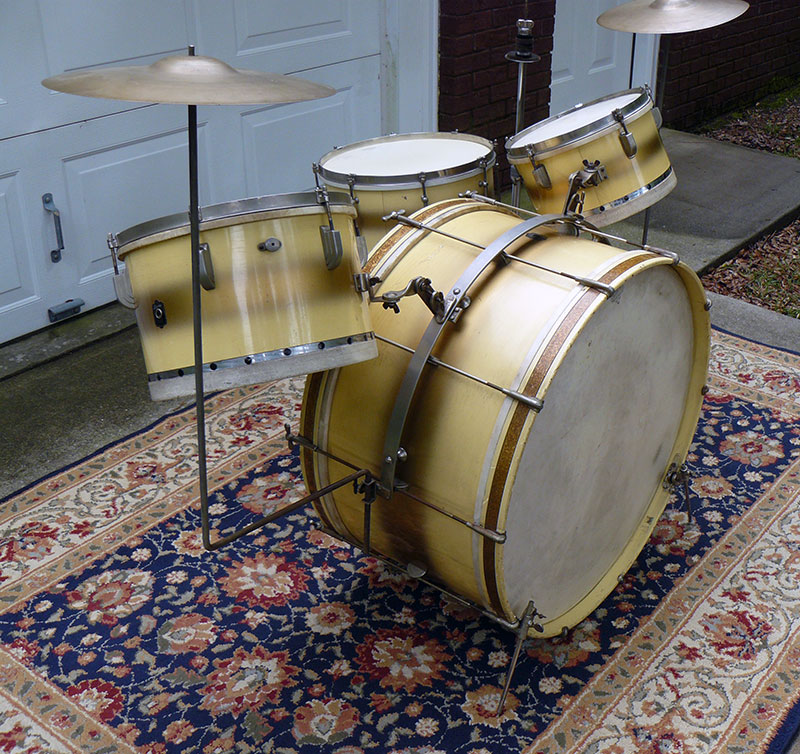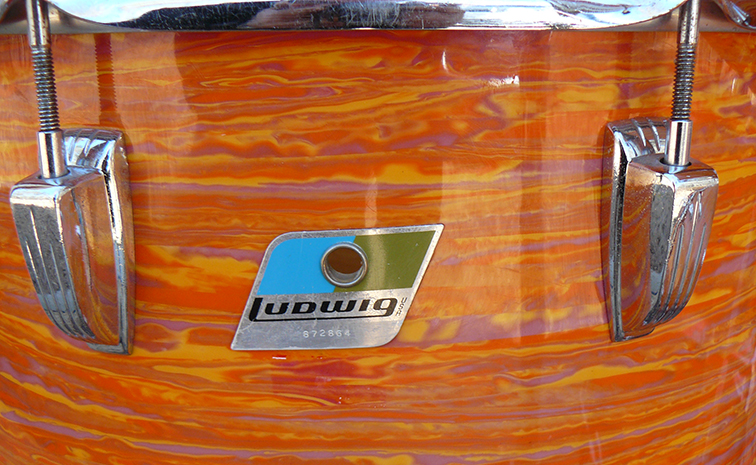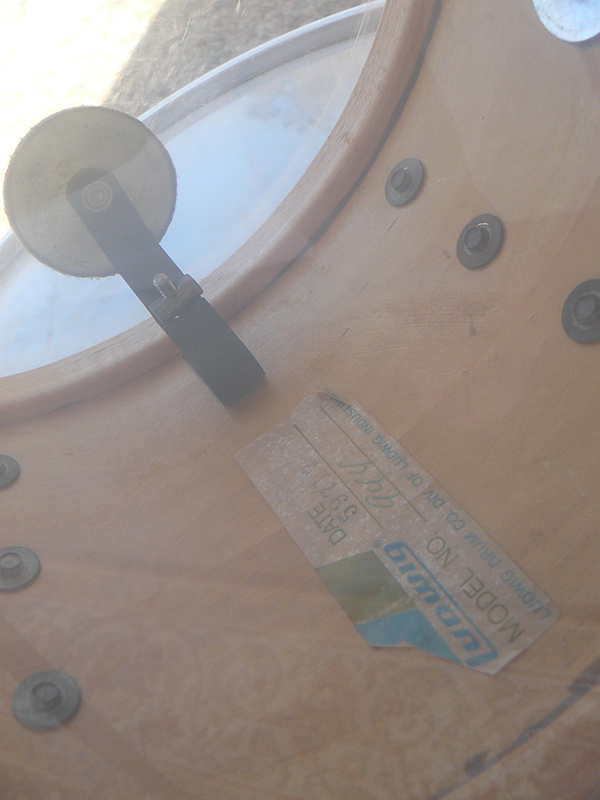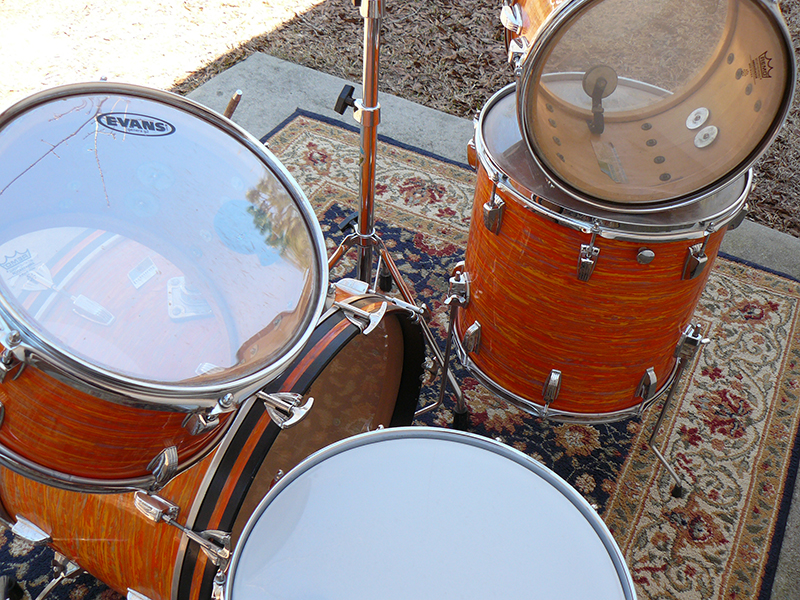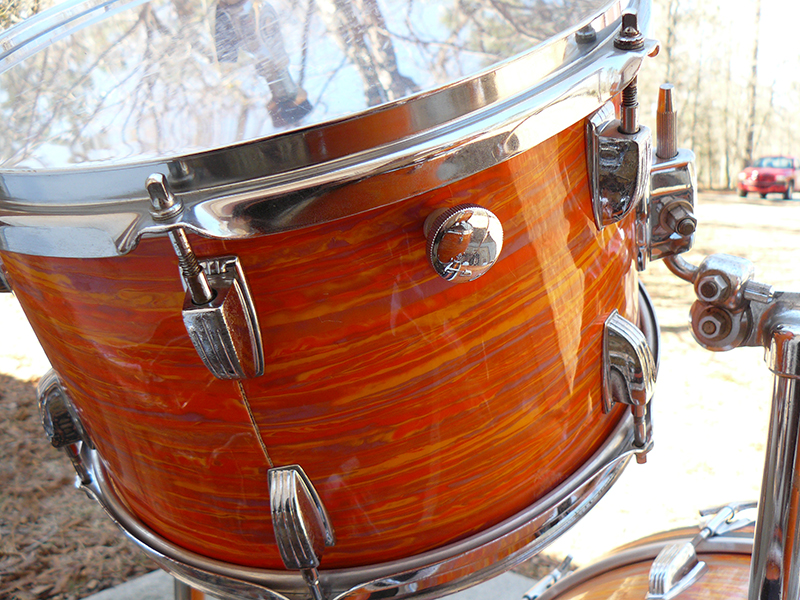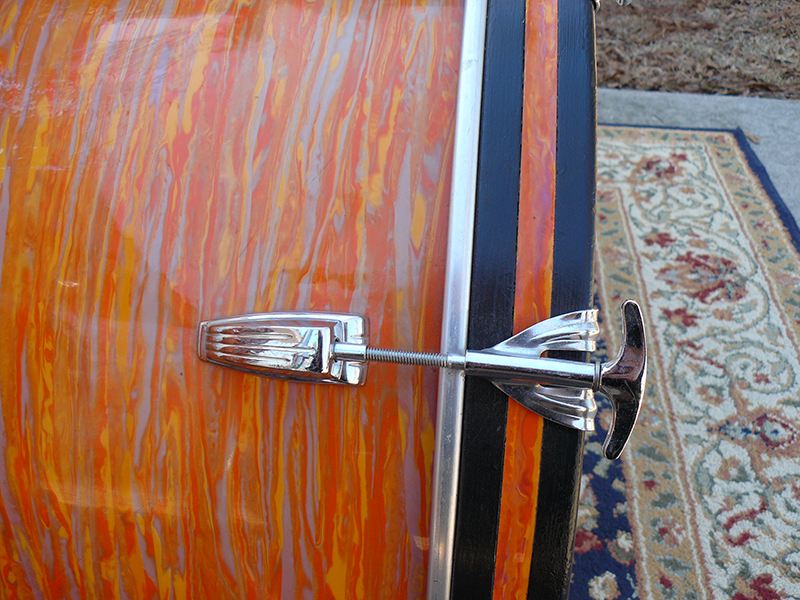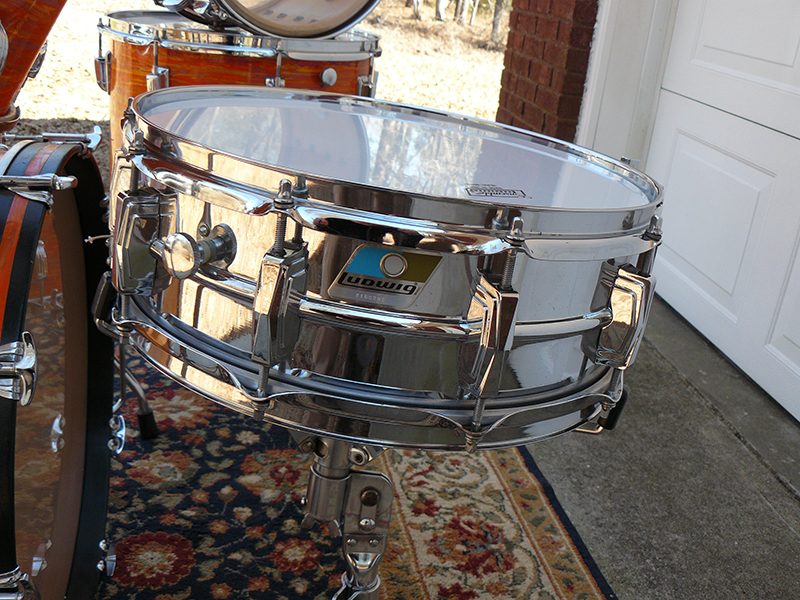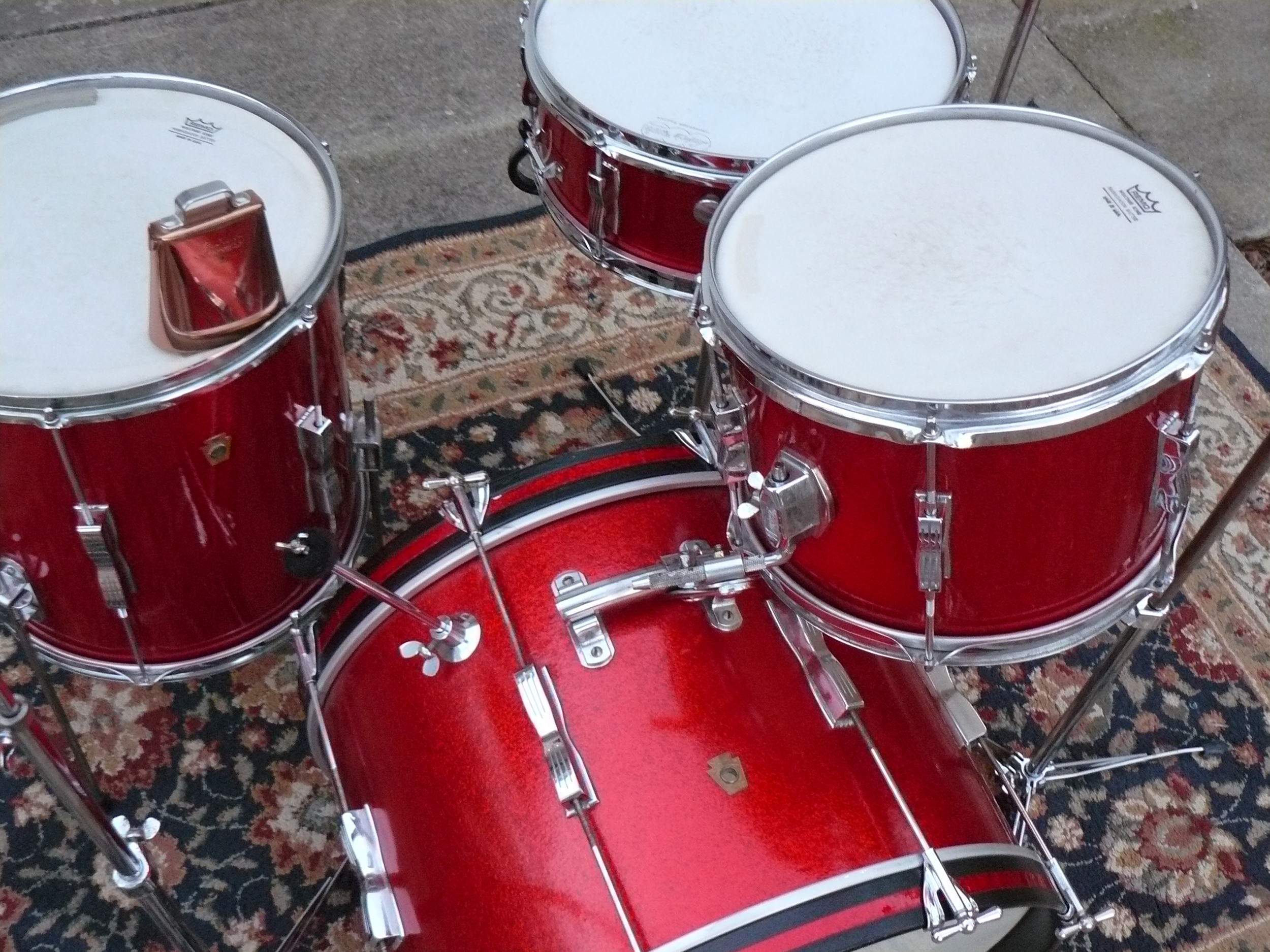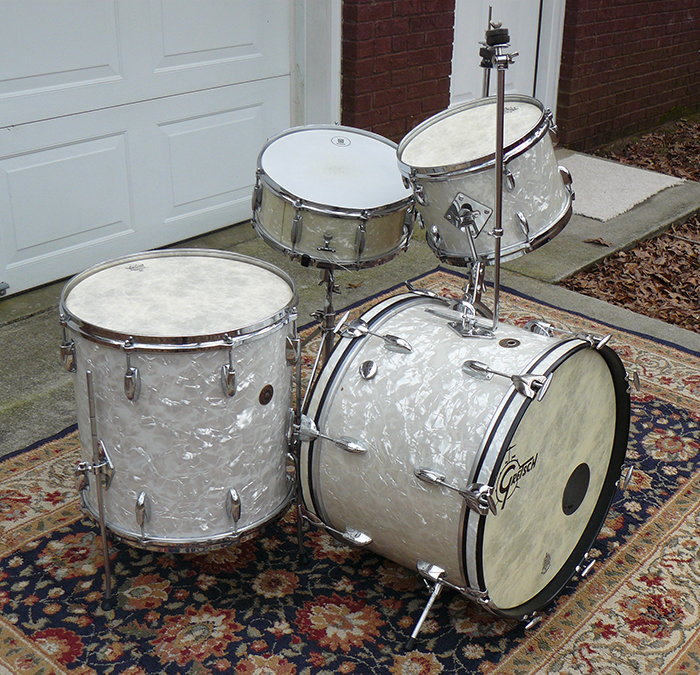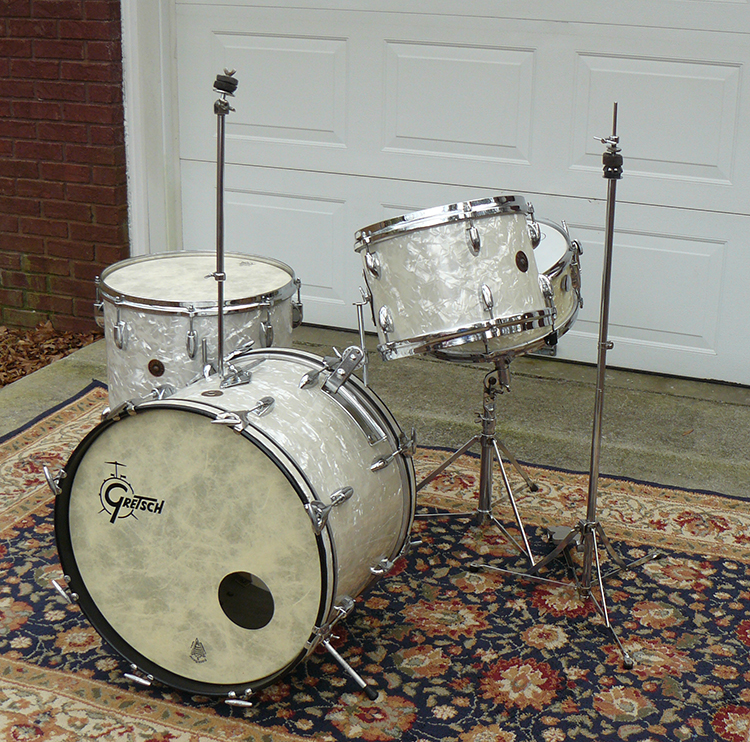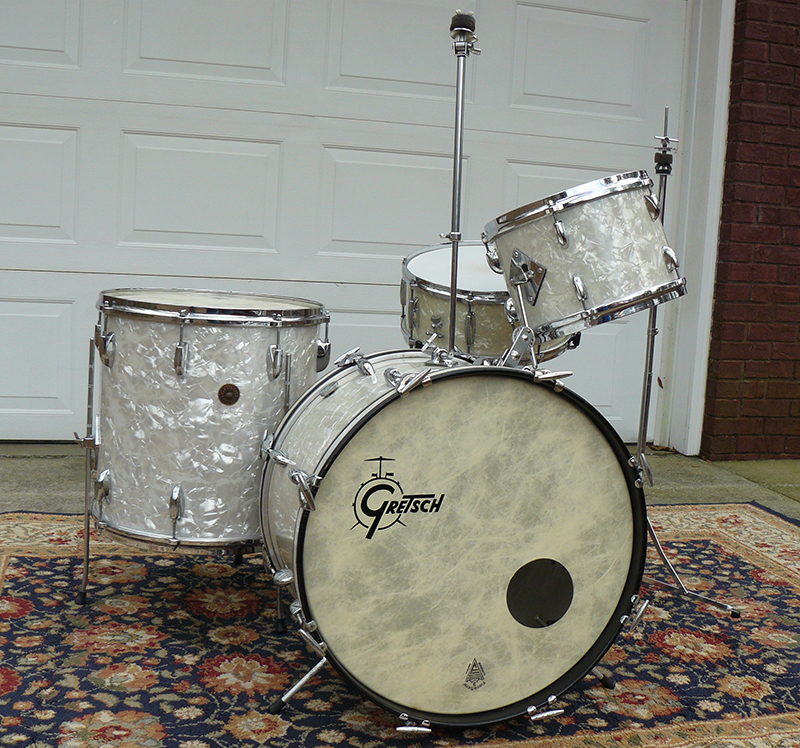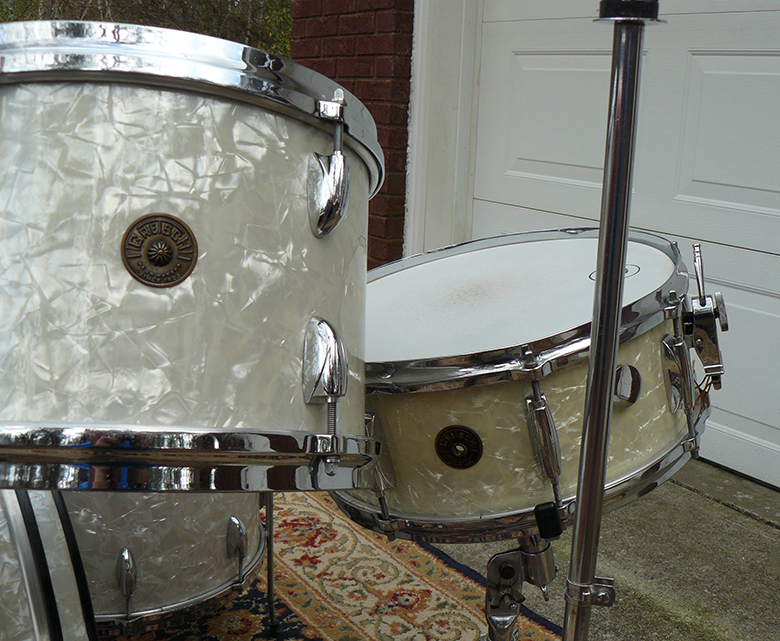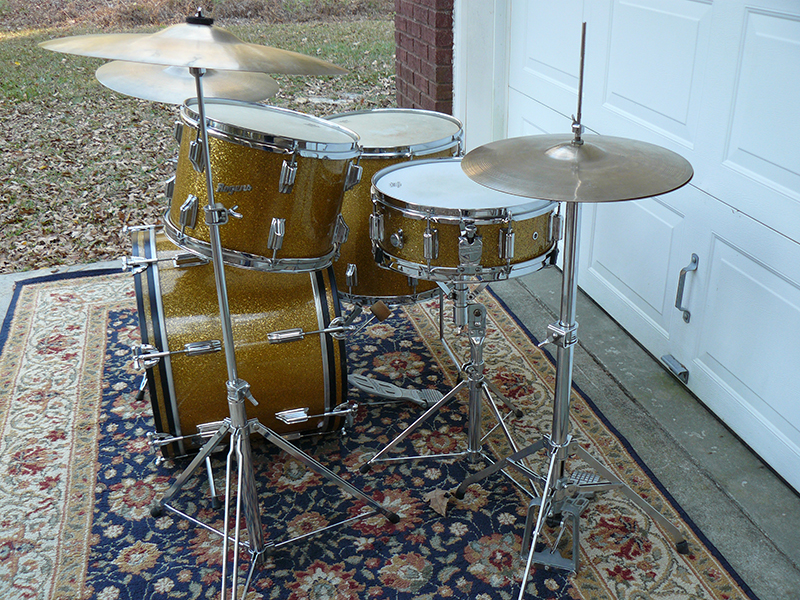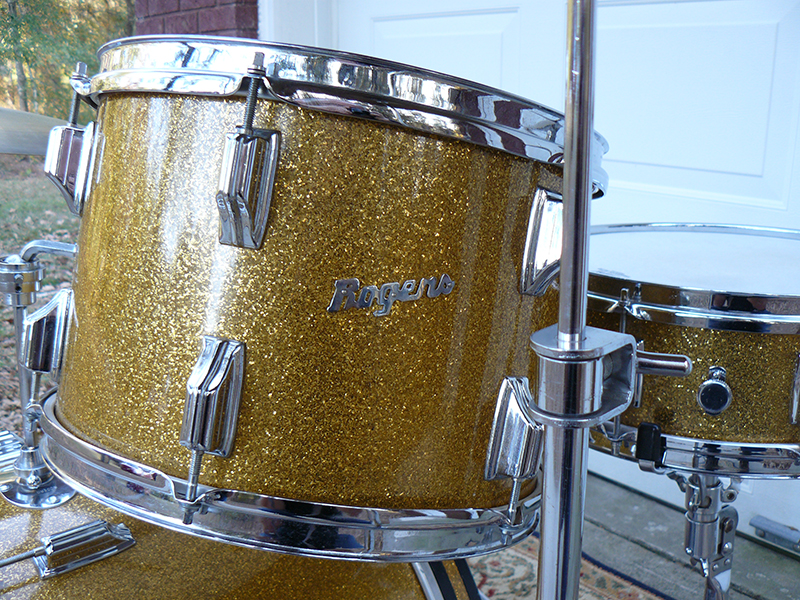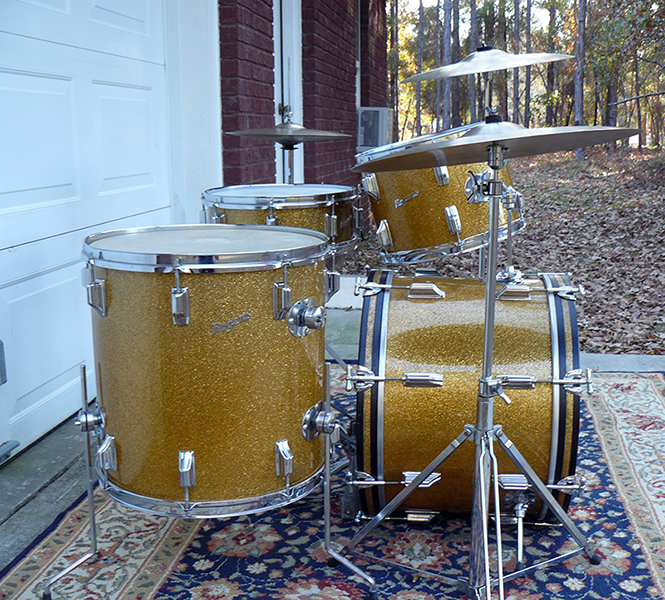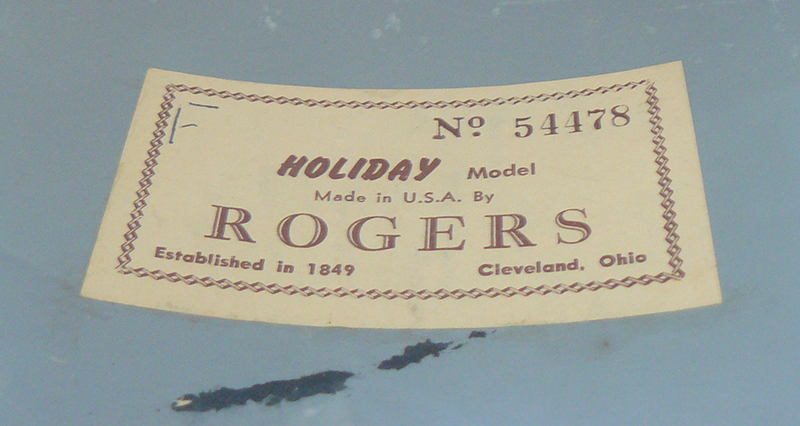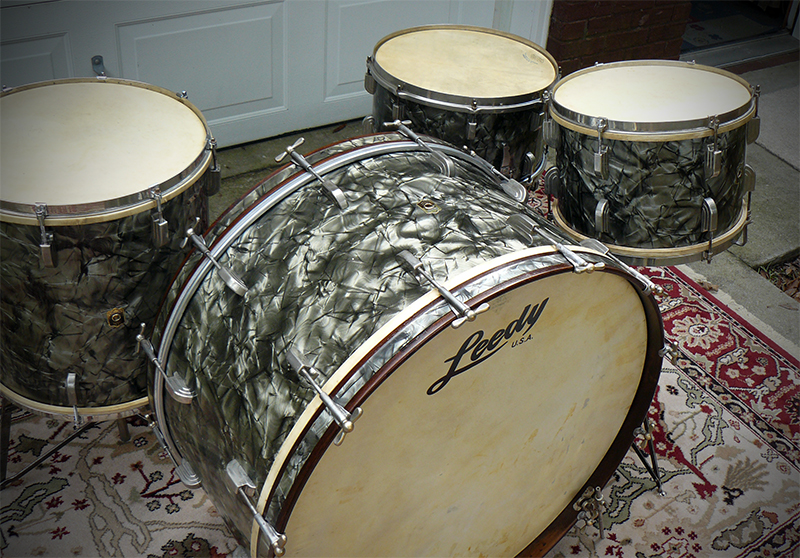This set of Ludwigs from my collection is covered in Sparkling Burgundy Pearl. This is one of the rarest sparkle finishes found on vintage drums today. Ludwig introduced this finish in 1967 having cancelled Galaxy Sparkle, the rarest of the Ludwig sparkle finishes.
Read more1970s Ludwig Blue Big Beat Vistalites
This set I am featuring from my collection is a 1970s blue Big Beat set. The clear and blue colors have been Ludwig's best sellers through the years. I suppose Amber and yellow also sold well thanks to the Bonham influence.
Read more1969 Ludwig Psychedelic Red Hollywood Drum Set
It's really warming up for us here in the deep south. I hope your Summer has begun well. I got out early this morning to photograph this drum set for my article and I am still sweating all over the drums as I set them up. I know this set is not mint, but they are a good example of this attractive and desirable finish. I have been writing for the magazine for a while and the reason they keep me around, I guess, is because I am just a regular collector like most of you. I am not a super rich man with unlimited funds to spend on drums. Boy if I were rich I would go wild at the drum shows and keep E-Bay and UPS very happy. Instead, I save for a while and look until I find a kit or snare that really turns me on. I have bought a few pieces every year for the past twenty years, and sold a few pieces now and then. I have sought to improve the collection as I go along. I will buy a set in a finish I like, and when the set in the same finish in better condition comes along, I'll buy it and sell mine. I really don't consider myself a hoarder. I don't have five matching drums in the same finish or anything like that. If I have an extra drum in a finish another collector wants I share up.
The set I am featuring this month is a beautiful Ludwig Hollywood set from 1969. The wrap is Ludwig's exclusive Psychedelic Red Pearl finish. The big drum companies of that day mostly shared the sparkle colors and pearl finishes on their drums, but no other drum company dared to offer this finish, so it was only on the Ludwig sets. Ludwig tried two other psychedelic finishes on their drums, but they were not as successful in sales compared to this awesome finish. I don't have the time nor words to describe what psychedelic means to us who were from the sixties, but suffice it to say we loved everything psychedelic during that period of our lives. The wild colors are a part of that movement, and these drums are very colorful. Someone described this finish as looking like a "frog in a blender." The badges are the Blue Olive parallelograms that replaced the Keystone badges that year. The interiors are natural maple that has been clear coated. The sizes are typical for the Hollywood sets. Bass drum 22"X14", floor tom 16"X16", mounted toms 13"X9", and 12"X8". The snare is a 14"X5" chrome Supraphonic. This was the type snare that went out with most of the sets sold.
This was one of the earliest sets I bought when I started my collection. When I was in high school, a friend got a double bass drum set of Ludwigs in this finish. When I saw those brand new Psychedelic red drums I couldn't believe how spectacular they looked. I never got over that, so I went looking to recapture that experience by owning a set like those. I told my good friend Bill Pace, who actually had a vintage drum store at that time, to let me know if he found a set I could buy. He called me one afternoon with the news that he had a set in his store if I wanted to see them. I took my son with me to share the excitement. We bought them and I have certainly enjoyed owning them ever since. They are not perfect, as I said, but if you get a chance to buy a set like this in almost any condition you should do it. The finish fades with time and light exposure. The green color is the first to go. Even faded they are still desirable.
I don't know if this will make the editors cut or not, but I also included a picture of a Ludwig factory Psychedelic wood shell Supraphonic re-issue snare drum Ludwig made for me just before they re-issued the color on sets fifteen years ago. I along with others had requested Ludwig re-issue the finish, and so I got one of if not the first one. The head was signed by Bill Pace who sold me the original kit and by the "Chief" Mr. Bill Ludwig.
DW Workshop Series
The Chicago Drum show in May was all I expected it to be. My only problem was I didn't have enough time to really dig in and see everything. My wife and I drove to our son and daughter-in-law's home in Charlotte on Friday. It was hard to sleep Friday night. I was extremely excited about going to the show on Saturday. My son and I started out early Saturday morning with a flight to Chicago. We rented a car and drove out to St. Charles to the fairgrounds where the show is held. I thought I would have plenty of time to see everything and visit with friends. There was so much to see and it was time to catch a plane back to Charlotte before I knew it. If I get to go back next year I will definitely plan to have more time. There were so many people there I wanted to talk to, and if I didn't get to speak to you, I'm sorry. I highly recommend that you go to a vintage drum show if you possibly can. Watch for announcements in the magazine for shows around the country.
The drum kit I want to feature this month is a beautiful set built by Drum Workshop. I know you are all familiar with the awesome drums this great drum company is making. The Collector Series is the flagship drums of Drum Workshop. They have the Aristocrat lugs like the ones made popular by George Way and Camco drums. Drum Workshop is built on the foundation of Way and Camco. The Workshop Series line of drums was the company's first attempt at a second line of drums. It was a set that was offered to the working and hobby drummer at a slightly better price, but still very high quality in every way. The most noticeable difference was the oval lugs instead of the round lugs. Another difference not so noticeable was the thin Keller shells without reinforcement rings. These drums sound fantastic. The first Workshop Series drums were limited in colors and sizes. That soon was scrapped because there were special orders for Workshop Series drums in special sizes and wraps. Drum Workshop officially only made the Workshops a couple of years, but continued to make them for special orders for quite some time.
The following information was gleaned from a drummer's forum. There was no name given, so I can't give proper credit. The facts are good and answers a lot of questions about these great drums.
BACKGROUND INFO ON THE DW WORKSHOP SERIES LINE:
"My drums are DW Workshop Series, made in the U.S. in 2000. There is much confusion surrounding this somewhat-rare line offered by DW.
I have read a lot of messages of people inquiring about DW Workshop series drums with most replies having bits and pieces of truth with some personal opinions thrown in. Lots of readers want to know about their quality and their price range. The Workshop series for the record were indeed 100% DW drums. They were manufactured in the USA (Oxnard), contrary to what some people have been stating. They were never made in Ensenada, Mexico. They were manufactured with what resembles the PDP lug to distinguish them from the Collector series.
They were built for only two years. They were made without reinforcement hoops, and were meant to be DW's good, mid-range product. Since they were just as expensive to manufacture as DW's Collector's Series, they were discontinued. Apart from that, they were favored by many DW endorsers in spite of the Collector's series.
They were DW's first go at manufacturing an American made "mass produced" set. They didn't offer the custom features like timbre matching and had limited finishes. The finishes were a high-gloss lacquered all-maple shell, or a Satin-Oil all-maple shell. The drums, aside from the different lugs, garnished authentic DW hardware as in the snare strainer. bass drum spurs and tom mounts. Again, 100% DW. DW dropped this line after about 2 years in production because they became too costly to produce, rivaling the production costs of their collector series, but they didn't carry the same retail price tag.
So with that, the line was scrapped in favor of the Pacific line. With the technology they gained making the Workshop series, they started to produce the PDP's in Taiwan. Pacific’s were not originally manufactured in Ensenada. DW chose to move the PDP line to Ensenada in the mid 90's to keep the costs down on the shipping tariffs from overseas and to be closer to the factory for quality control. But to state it one more time, the Workshop series was an American manufactured all-maple set. The sound is impeccable and they do not have the reinforcement ring for a broader sound, something DW is now offering (priced) on their Collector series sets. All the Workshop series drums have a DW badge with a serial number stamped on each shell stating "Made in the USA."
The Bottom Line Facts: These drums were "Made in the USA", with the same quality maple and parts that go into the Collector's Series drums. The only difference- apart from the differently-shaped lug housings, is that these have no reinforcement hoops. This difference is said to give them more sustain and a more open tone. I completely agree. I didn't buy these because they were less than the Collector Series: they just sounded better, more open, to me."
The toms on this kit I am featuring has a 10", 12" and 15" configuration. The bass drum is a thunderous 22"X18". The matching 14"X5" snare is also a very nice touch for this set. This set was obviously a special order and not a standard Workshop Series Kit. The tom sizes and the Ultra White Oyster wrap clearly had to be ordered. If you have a set of Workshop Series drums please comment. I live for your comments.
Hope you have a great Summer.
1960s Gretsch Name Band
Greetings,
I have some great friends who love, collect, and play vintage drums. It is indeed a pleasure to share this common interest.
My editor has put harsh and undue pressure on us to get an article out in time for the Chicago Show. I'm kidding about the harsh and undue part. The editor is really a nice guy, and we all love him and appreciate what he does to get us out a magazine about our passion every month. If you don't think he is doing a great job, you should try to do it. I am hoping I can be at the Chicago Show this year so I can see all my collector friends, and share some time together looking at and hopefully buying some new "toys." Getting to know and keeping in contact with friends who love these old drums is one way to know about good deals for buying, and also it opens up contacts for selling your items when you want to or need to move something. I would much rather sell to a collector friend than ship a great drum off to who knows where. I am not knocking those who sell their drums out of the country, but once that Black Beauty leaves this country it's definitely gone for good. I will get some negative comments about this for sure.
The set I am featuring this month is a 1960s Gretsch Name Band set in blue sparkle. Sometimes I have to tell you why a set is cool, but I don't think I have to tell anybody how cool this kit is. The set is made up of : 20"X14" bass drum, 16"X16" floor tom, 13"X9" ride tom and a very cool 14"X5" matching snare drum. The snare has eight lugs and the Micro-Sensitive strainer. An alternative 22"X14" bass drum was also available in the PX4015 Name Band set 1961-1976. These drums sound great. The shells are six ply with silver sealer inside. The blue glass glitter finish is still very strong and vibrant on these fifty plus years old drums. It is a joy to own and play an old "round badge" Gretsch drum set from around this era. The die cast hoops and distinctive hardware give them a distinct look. What I would call a timeless classic look. They are truly beautiful.
I was saying how great it is to have friends who also share an interest in vintage drums. I bought this drum set from Bill Pace many years ago when I was just starting out collecting. One of my oldest and best "drum friends" is Bill Pace from Forsyth, Georgia. I have been friends with Bill for a long time, and I can truly say with all our drum trading he has always been fair with me. I have tried to do the same with all my drum trading as well. We need to have some ethics and deal with people in accordance with the "golden rule." You know that one, right? "Tell all the issues with the drum to others as you would have them tell all the issues to you." I know you do that already because you don't want a negative feedback. In the old days the only negative feedback was you got a bad name if you didn't deal fairly. Bill is quite a character though. He will work hard to get a good price selling his drums, but he will work even harder to get your drums at a good price.
The funny thing about this set I am showing you is it was bought by Bill at a pawn shop. When he bought the set the floor tom I now have with the set was not with them, instead the set had a MIJ 16"X16"" blue sparkle floor tom. It was a Jet model drum. When Bill bargained with the poor owner of the pawn shop he really focussed on the Jet floor tom. He acted so disappointed that the set didn't match etc. etc. etc. The set was sold for a lower price because of Bill's whining. He sold me the set as a "One Nighter Plus" which was listed in the catalog without the floor tom. I later added the floor tom I now have to make the set a "Name Band" outfit.
1970s Ludwig Stainless Steel Hollywood Set
It's beginning to get warmer and there will be more yard sales, and sometimes drums appear out in people's front yards. I always brake for a yard sale to make sure there's not a sweet vintage drum for ten dollars in amongst all the junk. Check out the local pawn shops from time to time also. Tell the owner you would like a notification if any drums hit the floor. I have found some great snares and sets in pawn shops. Get your friends to be on the lookout for drums as they travel. I get a photo of a drum on my phone from friends quite often. Most of the drums they find are the newer variety, but I always tell them thanks for looking out for me. My friend Bill Pace puts an ad in the classified section in local towns. He says, "Old Drummer looking for Old Drums." It works for him, and he gets calls about drums families have in the attic. eBay and Craigslist aren't the only source of great vintage drums. Get out there and look for them, because if you don't, that brass Supraphonic will remain in that closet for many more years.
I have a real great set from my collection to show you this month. It’s a 1970s Ludwig Stainless Steel Hollywood Set. Ludwig introduced its line of stainless steel drums in the mid 1970s. These drums look so great and have a loud and powerful sound. They are also quite heavy. We all know John Bonham played a big Ludwig Stainless Steel kit soon after they came out with Led Zeppelin. The downfall of these drums was the cost to produce them. The same could be said about the Vistalite drums also. By the early 1980s the stainless steel shell drums were discontinued. They have been reintroduced in recent years for a limited run. The cost of the new stainless drums is very high. There are quite a few of these original wonderful sets out there for collecting and also playing. These drums from my collection are standard sizes: bass drum 22"X14, floor tom 16"X16", mounted toms are 13"X9", and 12"X8". The snare drum on display with the set is a 70s 14"X6.5" Supraphonic.
I have a couple of Stainless steel drum set stories I thought I would tell you. My good friend Lige Moore bought a great stainless steel set and loaned them to another friend. Our mutual friend's home burned with the stainless set inside. The Supraphonic snare drum was saved, but the rest of the kit burned. The shells came through the fire, but they looked pretty bad. Lige had a second 22" bass drum that I still have. I have his bass drum and snare drum in my stuff. Lige also gave me the shells that were burned, so I buffed them and sold them on E-Bay. They had no shine but they were still pretty cool. Another stainless steel story - I was doing some work for a man and the topic of drums came up. He told me he played and had a drum set in his house. I told him I also played and would really like to see his drums. I figured he would have an import set, but boy was I surprised to walk in to his drum room and find a flawless Stainless Steel set with all original hardware and Zildjian cymbals. I just never expected that set to be there in his house. He had bought them new in 1977 and he had never played them outside of his house. They were dusty and needed heads and a good cleaning to make them look like they had just come out of the music store. I asked him If he would like to sell them, but he said he didn't. I asked him about trading him a new set of Pearl or Tama drums for them and he said he might do that, but as of yet he hasn't. I'm not telling any of you where they are. I'm hoping he will let me replace them one day. My set is nice, but his is much nicer.
Make a comment if you have or play a Stainless steel drum set. I would like to get your feedback.
1960s Leedy Shelly Manne Set
I really like Leedy drums. I know some of you share my passion for these fine American made drums. I just love the history of this company, and besides, the drums are high quality and beautiful. When I was a young boy there was a sign artist that lived next door to us. He painted signs for businesses and such, and he was a very good painter. On day I went over to his shop and there was a drum head he was painting for a local band. They were called The Wild Cherries. I remember the look of the letters on the head and what stuck out the most was the Leedy logo on the head. I had seen the Ludwig logo on Ringo's drum head and I was not as dumb as some people to think it was part of the band's name. I had never heard of Leedy drums and so I guess I was dumb at first to think the band's name was Leedy the Wild Cherries. I soon started learning information about Leedy drums from another drummer who told me they were the same as Ludwigs. That information wasn't exactly right even though Ludwig and Leedy were owned by the same company for many years, and Leedy and Ludwig were even combined for a few years in the early 1950s. Then I had a friend who had a set similar to the set I'm featuring from my collection this month. He told me Leedy was not just like Ludwigs they were just like Slingerland drums. He was also somewhat right, because Slingerland bought Leedy from Conn in the late 50s and basically made what some people call "Slingerleedys". This drum set from my collection is a Slingerland built Leedy set from the early 1960s.
Leedy drums from this era (1956-1965) are very similar in every way to Slingerland drums with the exception of the lugs and badges. This set is a 22", 16", 13" set in standard depths. The lugs are Beavertail Leedy Lugs. You will hear the expression "Art Decco Design" when referring to these sleek modern looking lugs. The blue oval Leedy badges have Chicago 48, ILL. USA on them. This will date them 1960's. The first Leedy badge Slingerland made was a brass oval that dates drums mid 50s. The first blue oval badge '57-'58 didn't have the 48 after Chicago. The rims are "Stick Savers just like Slingerland drums. The Finish is yellowed white marine pearl. The set looks almost butterscotch. The yellowing is not consistent over the whole set. Something interesting to notice in the photos are the unfaded areas on the kick drum. The set had a cloth muffler across the batter head with excess cloth covering an area on the shell. Where the cloth shaded the shell the finish is still white. There is another white area where the front calf head was not tensioned equally. The place where the head covered the shell is still gleaming white. There was also a small sticker on the bass drum shell by the badge, and on the floor tom shell that covered a small spot. If the drums had been kept covered by a sheet when not in use they would probably be a lot whiter than they are now after 55 years. Any way, I still love that vintage "vibe" these drums have. They are beautiful to me.
I always share my adventures in collecting, because it is a lot of fun and exciting to score a great drum set. I buy some drums on E-Bay and I am not at all knocking that method of acquiring vintage drums, although It is like fishing in a barrel. It's more fun, and you really feel like you have scored when you find drums at good prices from owners or unlikely places. I realize that's more difficult now and it's becoming more difficult all the time. These drums were owned by my great friend Butch Braddy. I've told you before that he has helped me get a lot of drums over the years. He is the sales manager of the drum department at a large music store in a local city. He gets the opportunity to pass on or buy a lot of great vintage drums. I am so glad he's my friend. If he is letting something go or thinning his collection, I get a call. I try to keep some cash ready for just such an emergency. He called me recently to tell me about this Leedy set that he was parting with. I was there to lift his burden as soon as I could get to him. Thanks, Butch for this great set. Until next time, always peek into those dumpsters. You never know when someone has tossed out a Leedy Black Elite snare drum.
1960 English Rogers Set
It is hard for me to believe we are already in to February. Where did January go? My Mother told me when I was young and wishing for my birthday, Christmas, or school to be out that time would go a lot faster when I grew up. She was right, as always, and time now really get away in a hurry. I am looking forward, but not wishing my life away, to some great drum shows this year. I hope you can attend one in your area this year. Keep watching for the places and dates to be listed here in the magazine. Getting together with other vintage and custom drum collectors and players is always fun and educational. I am constantly learning information about vintage drums from my drum collector friends. A lot of my contacts and friends were made at drum shows.
I decided to feature a set this month for your enjoyment that I recently acquired. It's an early 1960s English Rogers set in rare Madi Gras finish. I have wanted a Rogers or Slingerland set in Madi Gras finish for years. I just love that finish. By the way, Madi Gras is this month in New Orleans. I've never been to Madi Gras, but I have that trip on my bucket list, but back to my desire for a Madi Gras drum set. I have been looking for a Madi Gras set to add to my collection, and as I was searching E-Bay a few weeks ago a set was there for sale. I really wanted them and had decided to place a bid when the end of the sale came around. I usually wait to bid until the end of the sale. I have jumped in right at the beginning, but usually I wait. Maybe you could leave a comment and share your E-Bay bidding strategy. The Madi Gras set on E-Bay was a Rogers set and that was fine with me. It's no secret to my readers that I love Rogers drums. While I was watching that set, another Rogers Madi Gras set showed up on Facebook. The set for sale on Facebook was the English Rogers set I am showing you. Yes, I made a deal with the seller and he shipped them to me from Canada. I am so excited about them.
English Rogers drums were made in the 1960s at the Boosey & Hawkes drum factory in London. They had Ajax three ply shells with reinforcement rings. The interiors are clear coated not painted like American Rogers. The lugs are Bread and Butter style, and the mounts are Swivomatic style, but they are different from the USA parts. The Madi Gras finish is also different from the American version, not as busy. The script logo badges also look different. The sizes of this set are: bass drum 20"X15", floor tom 16"X16", mounted tom is 12"X8", and the matching snare is 14"X5". Many of you know that Dave Clark of the Dave Clark Five played English Rogers drums. English Rogers drums were not a huge success, but they are very cool drums. Many collectors want to have a replica of John Bonham's set or a Ringo's set. I would like to have a red sparkle English Rogers set with a Dave Clark logo head. He was one of my greatest influences.
My set was owned by a member of the Toronto Symphony who brought them from England. When he returned to England to retire he left the set in Canada with a new owner. There is a cool Drum City London sticker on the bass drum. I was tempted to try to finish removing it. It looks like someone started to take it off but didn't go through with it. I have decided to leave it. It has been there fifty years, and it adds to the story of the drums, so for now the sticker stays. The man who helped me buy these drums from the owner who acquired them from the symphony percussionist was a super guy. He did a great job handling the sale and shipping the drums from Canada to my door. I want to thank him again for the great job he did. Leave a comment if you have an English Rogers set or if you liked Dave Clark Five. Keep looking in those unusual places for a great old drum.
1960s Rogers Cleveland Holiday Set
This set is a beautiful blue glass glitter finish that has developed a texture. They are not smooth to the touch. It is uniform over the complete set. I would like one of the Rogers experts to shed some light on this mystery for me. The paper labels inside indicate that these are Cleveland Holiday models. The solid grey interiors indicates that these are early 1960s. I have been told the Cleveland and the Dayton models were both made at Covington. Production was later moved to Fullerton.
Read more1960s Ludwig Downbeat Set
The drum set from my collection that I want to feature this month is a 1960s Ludwig Downbeat Set in sparkling pink champagne pearl. Downbeat sets began in 1959. It is one of my all time favorite kits. I really love these drums for many reasons. Their sizes are one reason I love them. These are the size drums Ringo Starr played on the earlier Ed Sullivan shows. The Bass drum is 20"X14", the floor tom is 14"X14" and the mounted tom is 12''X8". Ringo referred to the Downbeat sets he owned as the "mini" kits. I used to have a hard time telling if a kit was a Downbeat set in photos, but I learned to count the bass drum T- rods. The Downbeat set has 8 lugs and the 22"X14" Super Classics have 10 lugs. Another way to tell is to look at the lugs on the mounted tom. The space is greater between the top and bottom lugs on the 12'' tom than the space on the 13" tom. The 13" tom used on the Super Classics has larger lugs, so the space between them is smaller.
Read more1970s Camco Drum Set
Lately I have been bitten by the Camco bug. You might have been bitten by that bug yourself. There has been a rise in interest in these wonderful drums in recent times and I started wanting to own a Camco kit. I read the article about Camco drums here in the magazine with great interest. In the article the writer called them the "Stradivarius" of vintage drums. I have always thought they looked great, and wanted to own a set, so I finally made it a point to acquired a set for my collection. All the hype about these fine drums is true. They are very well built and sound fantastic. I think the first time I noticed them was when Dennis Wilson played a blue moire Camco set with the Beach Boys.
Read more1950s Leedy & Ludwig Broadway Set
I went in to the lovely home of the owner of this set. He is in his 80s, and after a few minutes of greeting I was taken to the set. It wasn't set up, but I was encouraged to set them up and play on them or whatever I wanted to do. I just enjoyed looking at everything. There was also a wonderful cymbal set included, some of them were "K" Zildjians. There were stands, other hardware, and a box full of great old percussion "stuff." After I had looked it all over, I sat down with the man and enjoyed a long talk with him. He has a life filled with great experiences and I'm glad I got to hear some of them. If I had left without the drums and only got to talk to this guy, I would still be richer from the experience.
Read more1990s Page Drums Custom Set
Hello vintage and custom drum friends,
It seems like Summer has made it, and it gets really hot here in Georgia, my home state. I am not going to complain after the long cold Winter we had. I'm sure some of you had a lot worse weather than us. We don't usually have freezing cold very much, but we had plenty of it this year. Enough talk about the weather, now we are going to talk drums. That's something all we drum fanatics like to talk about. The set from my collection I want to show you this month is a very cool 1990s Page Drums custom set. I first saw a set of these unusual drums on a television show. The show was called "Celtic Thunder". The musicians and singers were awesome to say the least, and the drummer was playing a set of these rope tension drums. I fell in love with the huge sound and the distinctively vintage look of the kit. I could easily see the large Page logo on his bass drum, so I started researching the drums and looking for a kit to buy.
The Page Drums were originally a product of a partnership of David Page and Jeff Hudson. Page Drums was a custom drum company from San Diego, California. This kit has a unique hemp rope tension design. 100 percent Keller 8 ply maple shells on toms and 10 ply on bass. The shells have no holes in them and the shells float between the 2 heads. These were billed as the most resonant drums on the planet.
The following comments were on the Page Drums web page:
"Each Page Drum is independently hand-crafted, made from the finest maple shells and hardware, stained or covered, and sized entirely to your specifications. The look of Page Drums is both classic, and uniquely your own. Originally introduced at the 1992 NAMM show, and twice nominated for "Best Acoustic Drum". Page Drums are the only totally resonant drum on the market. David Page has created a drum with absolutely no hardware attached or drilled into the shell. This concept completely eliminates any rattling or buzzing sounds."
The sizes of the drums are: bass drum 22"X18". Floor tom: 14"X14". Tom: 12"X12". Tom: 10"X10". The non free floating snare is a crackling 14"X3". The hardware is black powder coated. The tom Mounts are a combination of Rims mounts and Drum Workshop. The rope tension is very cool. The rope is pulled around the floating lugs with the tension rods loose. The rope is clamped in place and the tension rods are tightened to desired tightness. The extra part at the top floating lug is a sliding tension device like the ones that were on the old rope drums. The ropes are so tight the tension device will not slide down unless you leave the ropes very loose. The ropes will not tighten up "jazz" tight but will get fairly tight. Bottom and top heads tighten up together. The ropes can be replaced with cable to really crank them up. I love the look of the ropes though, and I don't plan to retrofit them with cables.
Jeff Hudson is now making these drums and calling them Hudson Custom Drums Los Angeles, California. He has a good website and facebook page. They are beautiful and very unique drums. Everyone that looks at my drums comments on this set.
In closing I'll just tell this little story about how I ended up getting this set. I had been looking for a set of Page Drums after seeing the "Celtic Thunder' show on Georgia Public television. I was browsing E-Bay just before going out to dinner. My wife was saying, "Let's go were going to be late," when I saw this set for sale. I could hardly believe it. They were just what I was looking for in the clear maple finish and everything, but there was only an hour left. I said, "Wait honey, I need to bid on this drum set." Let me tell you that set off a firestorm, and I had to work fast. The seller had a buy it now price, but it was high. There was also a make an offer option. I didn't want to lose them, but the thing is I never want to pay full price for anything. I made him an offer, turned off the computer and ran out the door. All through dinner I kept hoping he had accepted my offer. When I was finally able to get back to my computer I was pleased that he had accepted the offer. My wife accepts my "sickness" but she doesn't fully understand it.
If you have a set of Page or Hudson Drums please leave a comment. I would like to know what you think of them. Also, leave a comment if you have seen a set of these being used anywhere, or just leave a comment about anything. Sometimes I wonder if anyone is reading these articles.
Have a great Summer, Phil Wilson
Leedy 1940s Drum Set
Hello, vintage drum friends. I just love the old drums, and I'm sure many of you love them too. If you didn't you probably wouldn't be reading this magazine. There's just something special about the drums built in the 20s through the 40s. Most of the drums I own are from the 50's through the 70's. Those really appeal to me the most because those are the drums I grew up playing and wanting. The same is true of cars. I really dig the 50's through the 70's cars the most, but the pre 1950s cars are also very cool to me. Just like the really old cars with the big fenders, the really old drums have a special awesomeness about them. Those big bass drums and the sound of those old "tubs" give me goose bumps. I have a set to show you that I think has a great old vibe and I think you'll love them. It is a set made by the great Leedy Mfg. Company. They have a 1941 date inside. So they were built just before the United States entered into Word War II.
Leedy was one of the great American drum companies, and their drums were known for excellent quality. They were a very innovative drum company. The first drums they made were built in Indianapolis. The 20s were a wonderful time for the company. Leedy products were very popular. U.G. Leedy, the founder became sick and sold the company to Conn in 1929. The Leedy drums were made in Elkhart, Indiana beginning in the 30's. This kit has Elkhart badges. Throughout the 30s and 40s Leedy drums demonstrated American craftsmanship at its best. I recommend you read "Mr Leedy and The House of Wonder" by Harry Cangany for the story of the "World's Finest Drums".
This set is a matching four piece set in a beautiful Cream and gold Duco finish. More than likely painted by Mr. Ray Poland who worked in the finishing department for many years. I just love this finish. I wish I had the skill to paint drums like this. The sizes are: bass drum 26"X14", the small tom is "11X7", the large tom is"13X9", the matching Reliance Snare is "14X6.5". The toms have tacked calf bottom heads. The hardware is nickle plated. The toms have Beavertails on top with single flange rims and hooks. The bass drum has single tension with thumb rods. The rod passes through a bridge on the bass drum that matches the Beavertail lugs .The snare has 8 tube lugs, single flange rims with hooks, and the Presto strainer. These drums still sound great. They are a work of art as well as a great musical instrument. The metal mounting bar on the bass drum is very cool. All this metal was not allowed on the metal restricted war time drums that followed this set.
I went to buy a Ludwig Deluxe (Black Beauty) from a fellow collector. He was selling the snare for a well known recording and touring drummer. He showed me this Leedy reliance snare drum and told me the complete set was for sale if I was interested. I was unable to turn down the Leedy kit once I saw the snare drum. I ended up buying the Ludwig Deluxe and the Leedy set. I was very excited about the buying trip until I thought about how I was going to explain it to my wife. I surprised her once by coming home with a Rogers kit and a Slingerland kit we had not discussed. It took a while to explain to her what a great deal it was. Fortunately, she was very understanding, and she really liked the Leedy set. Who could resist loving a beautiful Leedy set like this? Until next time keep looking for those drum treasures.
1971 Ludwig Hollywood Mod Orange Set
Greetings vintage drum lovers and friends. I hope the Winter is on the way out and nicer warm weather is on the way in. I brought out a set out into the sunlight to show you that I try to keep in the dark as much as possible. It is a 1971 Ludwig Hollywood set covered with the rare Mod Orange wrap. The reason I keep them in the dark is to try to keep the color from fading even more than it already has. This color is one of the three Ludwig psychedelic wraps that caused quite a stir in the late 1960s and on into the 1970s. You have to be around 50 or older to understand why anything psychedelic was cool. The three psychedelic colors were, Psychedelic Red, Mod Orange, and Citrus Mod. These wraps are filled with color, but unfortunately they fade when exposed to sunlight. It is hard to find a set with these wraps on them that is not partially or severely faded.
My set is faded and has some cracks in the wrap and bumps and bruises. When you get a chance to own a Mod Orange set you will overlook a few flaws, because there are not that many sets out there to be had. The Reds are a little more plentiful. Ludwig did really well selling the Reds and then introduced the Oranges. The Oranges didn't sell as well as the Reds, even though John Densmore helped their sales by playing a set of Oranges with the Doors. The Doors were very cool, but you already know that. The Citrus Mods did even worse in sales than the Oranges and therefore they are even harder to find. A nice set of Citrus Mods will cost you big bucks.
The sizes of my Mod Orange kit is, bass drum 22"X14", the floor tom 16"X16", the toms are 13"X9" and 12"X8". The shells are three ply with reinforcement rings and clear coated inside. The white sealer paint inside the shells ended in the late 1960s. The toms have the rotary mute inside with the larger round handles outside the shell. The double tom mount is factory placed on the bass drum. There is a paper badge inside the shell that dates them to 1971. The Blue Olive badges are pointy on the corners which indicates early 1970s. The snare drum placed with the set is a 1970s 14"X5" chrome Supraphonic. It is very hard to find a wood shell Mod Orange snare. If you do you will pay a large ransom for it. Some Mod Orange snares have been recover jobs using a strip from a donor floor tom. Be careful when buying a Mod Orange snare drum.
Ludwig reintroduced the Mod Orange finish a few years back, but I think the results were about the same as the first time. I guess we will just have to say it's so ugly it's kinda pretty. You might still be able to purchase a version of this wrap if you would like to have this finish on a restoration job. Some have found Mod Orange wrapped drums that have been painted over. Can you imagine buying a pawn shop white painted Ludwig set and finding Mod Orange wrap underneath the paint. It will be difficult to remove the paint and not damage the finish. Get a professional to help you with that. Until next time, use cases and stop scratching up those future vintage kits, and keep searching for that Mod Orange Jazz Festival in somebody's yard sale.
Red Sparkle Ludwig Club Dates
These drums have a beautiful red sparkle finish as you can see in the photos. The sizes are typical for this era Club Dates. The bass drum is 20"X14", the floor tom is 14"X14", and the mounted tom is 12"X8". The snare with this set is a matching Pioneer 14"X5". Acrolite snares were offered with this kit beginning in 1966. There is cymbal mount on the bass drum that is factory placed near the batter head side pointing toward the floor tom. Also the small brass cowbell was featured with the set. They are light weight three ply shells with reinforcement rings. The unique characteristic about these drums is the center shell mounted "bowtie" lugs. Dual tension is achieved by long tension rods. The shells are painted white inside and have Keystone badges. The floor tom has "clipper" legs. The legs are straight and the holders are spring loaded with a push button adjustment. The mounted tom is attached to the bass drum by the "old faithful" rail type single tom holder.
Now the story. I was talking to a fellow drummer who told me he had just bought a new Tama drum set. I asked him what he had done with his old set? He said, "they are really old, in pretty bad shape, and they are beginner Ludwigs." I of course inquired about the "old, bad shape, Ludwigs." He told me I could come over and see if I wanted them. I asked him if right now would be too soon. If possible, go the minute you hear about a set, because things can happen so quickly and you will lose your chance.
He had let them get in very poor shape. They had no resonant heads or hardware, also missing were the front hoop and rods on the bass drum. A screw driver was employed as a bass drum leg. 30 years of dirt and grime was coating everything. I asked him," how much will you give me to take them away". He was mildy amused, and then said, I'll take $50.00 for them". Without haggling I gladly paid and loaded them up.
I spent a good bit of time and money putting them back in shape, but they are worth it. I even got some flat base hardware with the deal.My friend, Butch Braddy, drum dealer at a popular Georgia music store chain was asked to provide some authentic vintage drums to be featured in a movie. Savannah, Georgia has become a favorite spot for many movie makers to shoot films. Butch and I provided the drum sets for the movie about the CBGB Club in New York where many famous bands made their debut. This set is in the film. I haven't actually seen the film yet, but I did watch the trailer, and can't wait to see these Club Dates in their starring role.
Keep looking for those great vintage drum deals.
Phil Wilson's 1950s Gretsch Set
Greetings vintage drum lovers,
Old man winter has finally made it. It's probably cold where you are and probably you are getting some of the "white" stuff around your home or business. Being from Georgia, we hardly ever get snow, but I like "white" drums falling into my lap.
I bought this wonderful white pearl 1950s Gretsch set a while back from a man who brought them right to my door from New York. I'll tell you more about how I was lucky enough to get them after I describe them.
I believe this set is from the late 1950s because I have been studying up on them in "The Gretsch Drum Book" by Rob Cook and John Sheridan. If you don't have this book you need it. It is a great source of information about everything Gretsch. The shells are heavy three ply with silver sealer inside that dates them in the late 1950s. There are no orange labels inside that started in the early 1960s. The round badges were used from the 1930s through the 1960s. These "round badge" Gretsch drums are very collectible. They are also great sounding drums. The sizes of these drums are bass 20"X14", the ride tom is 12"X8", the floor tom is "16X16". The matching snare is 14"X5". The snare has the Micro-Sensitive strainer. There is a diamond plate cymbal mount on the top center of the bass drum. The distinctively Gretsch bass drum T-rods have been used since 1958. Another cool feature is the long lip extension rod to raise the tom tom.
One good thing about having my name out there as a collector is I get calls when someone wants to sell a vintage drum set. I can't buy them all, but I try to give advice to everyone who calls or E-mails me. A man from New York E-mailed me to try to get some advice about this drum set. He had no idea they were valuable. He had listed them on Craig's list trying to trade them for a Kayak. He said he had twenty responses all wanting to buy him a Kayak and get these drums. He ask me if I wanted to buy them. He told me I was his second call. He had already called a very well known drum seller. This drum seller is a friend of mine, and he had given him a dollar amount that he felt they were worth. I ask him if my friend had offered to give him that much. He said well,no, but he said "that's what they are worth." I said," they are only worth what someone will give you for them." He laughed and asked if I would like to see them. He said that he and his family rode right by my town going to Florida for vacation, and he would bring them if I wanted them.
I was very excited when he arrived at my door and we unloaded this set. It was very dirty and needed a lot of love and attention, but I could tell it was a very desirable set. I made him an offer of cash and he accepted it. He said,"I have another old drum I want to give you". He reached under the seat and pulled out a 1960s Keystone badge Ludwig Supersensitive. It was in excellent condition. That was just a bonus to the deal. I was smiling when he left.
Every now and then do a roll, Phil Wilson
The Rogers Holiday Set
Holiday Greetings,
It's the Holiday season, and I have a great Holiday drum set to show you this month. Rogers drums are very cool and so collectible. I am always on the search for a nice Rogers set, and love the history of this great drum company. In the beginning this company was a drum head manufacturer. Rogers became the makers of some of the best drums ever made. By the time this featured drum set was made, Rogers drums were the most expensive of all their competitors.
I will tell you how I came to own this set after I describe them. They have script badges. There is a script badge on both sides of the mounted tom. The shells are maple with reinforcement rings. The lugs are Beavertails. The Beavertail lugs were a great improvement over the Bread and Butter lugs which would crack very easily. The Swiv-o-matic tom mount is factory placed in the center of the bass drum. The floor tom has a factory extra knobby. The bass drum is 20"X14", the floor tom is 16"X16", the ride tom is a 13"X9" and the snare is a matching 14"X5" Powertone. The finish is a vibrant gold sparkle. The interiors of the drums are painted solid grey. That indicates that they are early 1960s. The tags inside indicate that they are Holiday Model drums. The Cleveland tag means the drums were warehoused and sold from Cleveland. After CBS bought the company in 1966 warehousing was moved to Dayton. All these drums were made at Covington, Ohio. The Dayton drums have grey speckled interiors. There is no difference in the quality of pre-CBS and post-CBS drums made in Ohio. The factory was later moved to Fullerton, California.
The drum salesman at the music store gave me the number of the man who was selling some Rogers drums. He said he had several Rogers sets and wanted to sell some of them. We set up a time that I could come to see the drums and hopefully get a set. When my wife and I got to his home it was very upscale. To make a long story short, he took us to a room filled with beautiful Rogers drums. There were red onyx, grey ripple, and other beautiful kits in there. I soon learned that none of these sets were for sale. He took us to a cabinet where there were five Powertone snares displayed. White pearl, blue sparkle, gold sparkle, red sparkle, and I'm not sure about the last one. I think it was black diamond.
The guy said he had the full kits to match each of these snares and everything is in pristine condition. I said “great! Let's see them”. He said, “Which one?”. This was most unusual for me. I wanted to see them all, but I could tell he really didn't want to drag out all those drums, so I said “Let's see the white ones”. He said, “Follow me” and we went downstairs and into a closet. He pulled out a case then two. Inside were the tom toms and they were very nice. I said, “You know, I would like to see the blue ones too”. He put the toms back in the case, put them back in the closet, and said, “Follow me” again. I began to feel like if I wanted to go to the next one there was no turning back. My wife was still in the big drum room and I was going on the hunt through the house with the owner. We got to the blue ones, also in a little room in cases. It was the same as before. “Do you want these?” “I would like to see the gold ones.” He packed everything back up and led me away to another room. By this time I was getting concerned about my wife, and I began to think I better pick one or else I would lose my chance. When I saw the gold ones - this set I'm showing you - I said “that's it!.” He was pleased that I didn't have to see them all. We made a deal and I loaded them up. It was really a fun experience.
I hope you have a safe and enjoyable holiday season. Keep looking for those great attic finds.
Later, Phil Wilson
The 1941 Leedy Set
HELLO AND HAPPY FALL!
The air is cooling down and the leaves are beginning to change colors. It's time to put away the summer clothes and get out the long sleeves and sweaters. I have a very "cool" old drum kit to show you this month. I know I featured a black diamond kit last time, but this black diamond set has "greened" a little giving it a completely different look. The set I want to show you is a 1941 Leedy. I have all five pieces. It was bought as a set in the year they were made and was owned by one gentleman until his death a few years ago. The man played this set with an orchestra until he purchased a Ludwig set in the 1960s. He put this set away in storage and that's where it stayed until his son decided it was time to find a new owner.
I'll tell you more about how I was fortunate enough to acquire them later. The sizes are: bass drum 28"X14", toms 16"X16", 13"X9", and 12"X8". The matching Broadway Parallel snare is 14"X8". The shells are plies with re-rings. The lugs are Beavertails introduced in the late 1930's. The insides of the bass drum and snare are painted white like Ludwig. Conn owned both Ludwig and Leedy when these drums were made. They were made side by side and yet maintained differences. Conn finally joined the two lines in the 1950s and made Leedy Ludwig Drums. The Ludwigs bought the Ludwig line back in the mid 1950s and Slingerland bought the Leedy line. You already know all this, I'm sure.
These drums were made in Elkhart, Indiana. The workmanship is excellent. The date stamp inside is January 1941. That was just months before Japan bombed Pearl Harbor bringing the United States into the World War.
The mark inside also says "For Pearl". This means the shells were marked for a pearl wrap finish. The black diamond finish still looks very good although age has made it look sort of green. The hardware is nickel. The heads are calf with the exception of the bass drum batter head.
The son called me and told me he had gotten my number at the music store. He asked me if I would be interested in a very old Leedy drum set. After catching my breath, I calmly said, "sure, when can I come see them." Never say what do you have unless it's a very long drive. My wife went with me, and there they were all spread out on the garage floor. He said the head with orchestra name and his Father's shield logo had been destroyed. The mounts were gone and some of the rods and clips. He gave me a great deal , because he was tired of storing them. It was very exciting to load them up. I have enjoyed the clean-up and having the great piece of history in my collection. Oh, What about the Ludwigs?, some of you are thinking. He said his step-mom had disposed of them and I could tell it was not a subject I wanted to pursue.
Until next time, Phil Wilson


